#detailed maps of every part of the continent it occurs on
Explore tagged Tumblr posts
Text
Watching people complain about ST not making its characters and world complex enough as I read through 5000 years of lore (on top of the game itself) for FFXVI:

#I forgot how FEROCIOUSLY spoiled fans of these games are with the lore and development oh my GOD#like. full histories of nations level depth. character motivations over the course of their entire lives#detailed maps of every part of the continent it occurs on#even specific character themes having lyrics explains their motives + background + development? LIKE#it’s so delightful to see so much detail IN PLAIN SIGHT like#I don’t have to hunt for it I don’t have to do fucking summersaults#it’s just there#clear as day#for interpretation and expansion skdhndjdjfb oh my god I can’t WAIT for the dlcs lmaooo#ffxvi#the me tag
13 notes
·
View notes
Text
Morrigan's Milanote Mess
aka "a look at how I plan my story using Milanote"
[Note: I have a subscription, so I'm not limited by the number of cards I can have, otherwise this level of detail would be impossible. My subscription was a gift, though.]

So, this is the "landing page" for my story. The left column has my "poster", and underneath that is the summary I have on my info page on my blog. The other two columns, on the right, have links to the boards that make up this mess.

This is the "outfit catalogue" board. It has pics of the outfits for every sim involved in the story, along with notes on how I have used / will use them. (The order here is meaningless. The top row is just the order from my character page on my blog, and the other ones are just grouped by their relevance / if they actually show up.)

This is what part of the outfit catalogue actually looks like. I note what I might use the outfit for, and also any notes about it. (Is it out of character for said sim? Would it only be worn for specific occasions? Is it formal or casual? Is it for warm or cold weather? etc.)
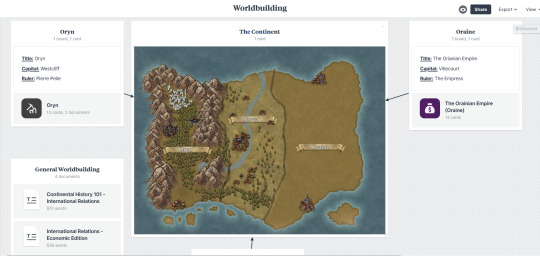
This is the main worldbuilding board. Each kingdom on the continent has a section, and there's also a place for all my rambles about the world. (Anvia is on there, just cut off.)

Each kingdom's board looks like this. There's a couple more sections underneath, along with a doc for more in-depth rambles.
Now onto the actual planning portion!!
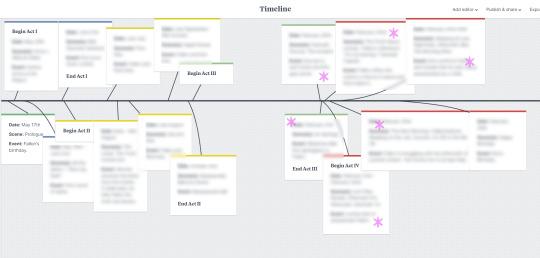
I've shared this pic before, but this is my overall timeline for the story. (It really needs an update, though.) I have mapped out the dates of when certain key events occur, as well as when the transitions between the Acts happen. (Blurred for spoilers.)
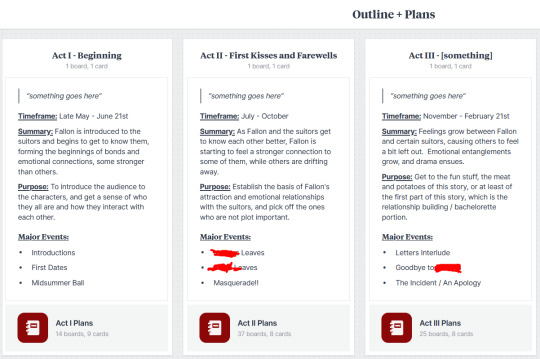
This is the main landing page for my planning though. Each Act has a spot that includes the timeframe, a summary of events, as well as what I want to accomplish during that act to move the story forwards. (Acts 4 and 5 not included for spoiler reasons, plus Act 5 doesn't fit on the screen without scrolling.)
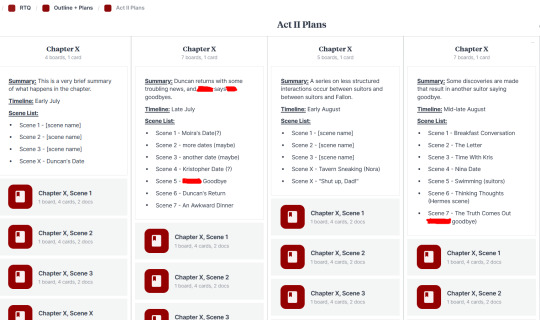
Each individual Act looks like this, but with more chapters (again, they don't all fit without scrolling). This is a look at Act 2. I have a column for each chapter, with a list of scenes, as well as the timeline of the chapter.
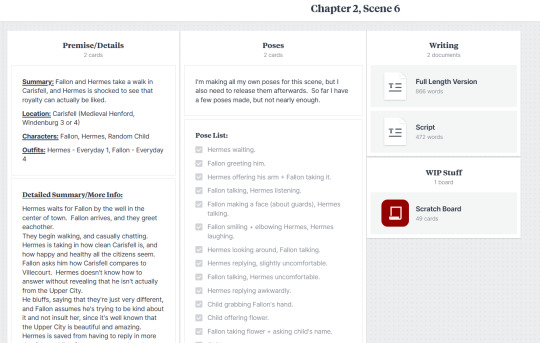
The board for each scene looks like this. I have a super short summary, the location (including which of the 6 copies of Windenburg said lot is in), who's involved, and what they'll be wearing (cross-referenced with the Outfit Catalogue, ofc.). Then there's a more detailed summary that summarizes the beats/themes of the scene, as well as has some insight into what the characters are thinking and feeling. The poses section varies from scene to scene, but the top section is for me to list any accessories I need, or any existing poses I have that might suit my needs, as well as rambling about the poses I might need to make. The checklist part is for the poses I need to make myself, usually. The writing section contains two versions of the scene. A full-length prose version (since I do that sometimes for fun and practice), and the actual script. The script is essentially what I type on the screenshots, as well as was goes in the transcript under the cut.

This is what the scratch board looks like. It's where I dump all of the screenshots I take for the scene, and sort them out. I decide which ones I actually want to use, and put them in the right order. Then I decide what portion of the text is going to go on which screenshot. (Better example below)

Phew! Okay, that's everything!! (Except for the character boards but those are kind of spoilery and I'm in the process of replacing them anyways.) Hopefully this was at least kind of fun to look at. It honestly amazes me how organized this is, because literally nothing else in my life is even remotely organized, lol.
I should also note that it was @mellindi who originally keyed me into the idea of using milanote for story-planning, and some of my layouts take inspiration from hers.
34 notes
·
View notes
Note
I want to indulge the brainrot. Talk about Pixlriffs and the way his citizens see him, or the guiding role he tends to take within the Codvengers, or why he grew his hair out. I like your thoughts, though, so if something else has the rambling’s attention right now, go wild!
i have lots of thoughts about pix’s role as the “king” in pixandria!!! the pixandrians wouldnt follow the traditional king/queen/emperor/leader roles that most of the other empires do. the title of the Copper King was given to pix by the other emperors who assumed he was a king, and similar to this his crown is only worn in other empires or around other leaders as well. …exceptions occur when he forgets to take it off. pixandrians follow the vigil keeper, which is considered to be more of a priest role than that of a king, even if they have similar responsibilities. pixandria has been around for potentially thousands of years, but pix was the first vigil keeper to make the effort to have trade routes with other empires and put the empire on the main maps.
the keeper is chosen by lightning in a rare desert storm. theres no fancy ceremony, coronation, or crowning; one day the keeper is struck by lightning, leaving a lightning scar (not sure what its called but its the same thing that can happen irl) made of copper. pix was going about his day as normal when a lightning storm hit the desert, and basically he couldnt get inside fast enough, so he got struck by lightning that brought with it a ton of responsibilities. (it may or may not cause a respawn as well, but that has no change on the outcome. the person struck would still be the keeper) i dont know where his scar is yet but it might start at his hand and travel up his arm, connecting with his channeling trident when he uses it. (the electricity might cause it to glow as well!!) rain is very important in pixandria, and storms are celebrated whether or not its a lightning one. a storm where the keeper is chosen is incredibly rare and does not happen every time it rains. the new keeper will be taught by the old one until they are ready to be The keeper.
only the vigil keeper is able to light the candles on the vigil for the other emperors, as it is a big part of their role. the candles do not control respawn or death, rather they are lit to respect and honor the fact that one has died. death is not typically feared in a world with respawns, but that does not take away from the fact that its still a Death and that should be acknowledged. the candles also do not go out unless the person it is lit for permanently dies (typically of old age or injuries/disease that override respawn mechanics), in which case it can no longer be re-lit. when a player permadies, the candle is said to be the light that guides them to the afterlife; by the time the wax melts down and the candle is nothing but a stub, the dead have made their way. families light candles for their own in their homes, the vigil is only for the emperors of the continent. there is a lantern lighting ceremony every 6 months where the candles are exchanged for lanterns and they are all sent into the sky at once. a common pixandrian parting (whether in death or a simple well-wish) is “may the vigil guide you home.” - home being a home in the literal sense, or the afterlife, its up to interpretation and/or how the speaker intends it!
i havent thought of the specifics yet but because long hair is kind of impractical in the heat of the desert (i assume), a vigil keeper growing out their hair could be a symbol of status? thats not to say the general pixandrian public could not also have long hair, though, so maybe its just a personal preference. although it could be used as a story-telling detail when he exiles himself & cuts his hair short. i just like drawing long hair, honestly, but i might solidify a reason for it in the future :D
#always always open for more asks abt headcanons btw whether pix or not#genuinely just send an ask any day and ill go wild when i see it#it makes my day#headcanon.png#ive been typing this for over half an hour bc i tend to leave words out when im excited without realizing it so i had to edit it a ton#theres still probably mistakes tho bc every time i reread it i added more#many thoughts head full i just dont wanna have an overly long post#pixlriffs
23 notes
·
View notes
Text
21 Years of Amazing Earth Imagery
On April 29, 1999, NASA Earth Observatory started delivering science stories and imagery to the public through the Internet. Today, we turn 21! So much has changed in the past two decades...
youtube
One of the most notable changes is the way we view our home planet. Check out some of the beautiful imagery of our planet over the past 21 years.
2000: Pine Island Glacier
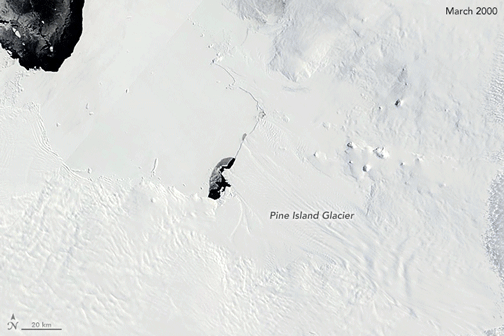
Most people will never see Pine Island Glacier in person. Located near the base of the Antarctic Peninsula—the “thumb” of the continent—the glacier lies more than 2,600 kilometers (1,600 miles) from the tip of South America. That’s shorter than a cross-country flight from New York to Los Angeles, but there are no runways on the glacier and no infrastructure. Only a handful of scientists have ever set foot on its ice.
This animation shows a wide view of Pine Island Glacier and the long-term retreat of its ice front. Images were acquired by the Moderate Resolution Imaging Spectroradiometer (MODIS) on our Terra satellite from 2000 to 2019. Notice that there are times when the front appears to stay in the same place or even advance, though the overall trend is toward retreat. Read more.
2002: The Blue Marble

In February 2002, Earth Observatory published this “blue marble” image based on the most detailed collection of true-color imagery of the entire Earth at that time. Using a collection of satellite-based observations, scientists and visualizers stitched together months of observations of the land surface, oceans, sea ice and clouds into a seamless, true-color mosaic of every square kilometer (.386 square mile) of our planet. Most of the information contained in this image came from Moderate Resolution Imaging Spectrometer (MODIS), illustrating the instrument's outstanding capacity to act as an integrated tool for observing a variety of terrestrial, oceanic and atmospheric features of the Earth. Read more.
2009: Tsauchab River Bed

The Tsauchab River is a famous landmark for the people of Namibia and tourists. Yet few people have ever seen the river flowing with water. In December 2009, an astronaut on the International Space Station caught this glimpse of the Tsauchab River bed jutting into the sea of red dunes. It ends in a series of light-colored, silty mud holes on the dry lake floor.
Like several other rivers around the Namib Desert, the Tsauchab brings sediment down from the hinterland toward the coastal lowland. This sediment is then blown from the river beds, and over tens of millions of years it has accumulated as the red dunes of the Namib Sand Sea. Read more.
2012: Manning Island and Foxe Basin, Canada
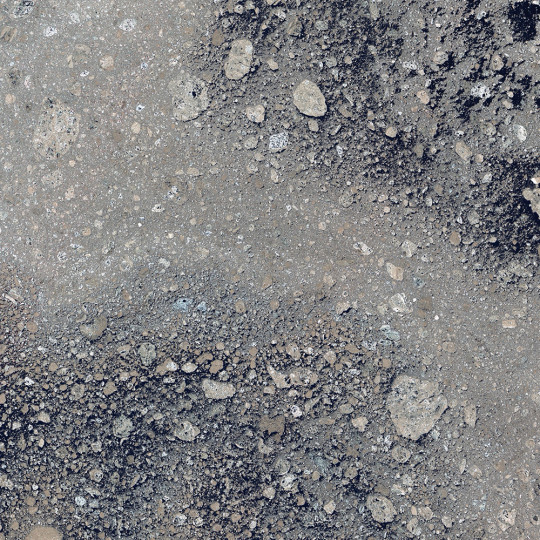
Although it may look like a microscope’s view of a thin slice of mineral-speckled rock, this image was actually acquired in space by the Earth Observing-1 satellite in July 2012. It shows a small set of islands and a rich mixture of ice in Foxe Basin, the shallow northern reaches of Hudson Bay.
The small and diverse sizes of the ice floes indicate that they were melting. The darkest colors in the image are open water. Snow-free ice appears gray, while snow-covered ice appears white. The small, dark features on many of the floes are likely melt ponds. Read more.
2013: A Lava Lamp Look at the Atlantic

Stretching from tropical Florida to the doorstep of Europe, this river of water carries a lot of heat, salt, and history. The Gulf Stream is an important part of the global ocean conveyor belt that moves water and heat across the North Atlantic from the equator toward the poles. It is one of the strongest currents on Earth, and one of the most studied.
This image shows a small portion of the Gulf Stream as it appears in infrared imagery. Data for this image was acquired on April 9, 2013, by the Thermal Infrared Sensor (TIRS) on the Landsat 8 satellite. TIRS observes in wavelengths of 10.9 micrometers and 12.0 micrometers. The image above is centered at 33.06° North latitude, 73.86° West longitude, about 500 kilometers (300 miles) east of Charleston, South Carolina. Read more.
2016: Curious Ensemble of Wonderful Features
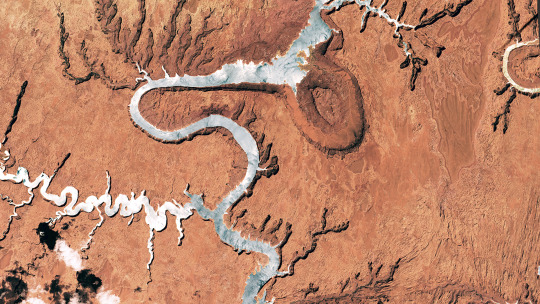
When John Wesley Powell explored the Colorado River in 1869, he made the first thorough survey of one of the last blank spots on the map. The expedition began in May at Green River, Wyoming, and ended three months later at the confluence of the Colorado and Virgin Rivers in present-day Nevada.
About two months into their journey, the nine men of the expedition found themselves in Glen Canyon. As the men traveled along the serpentine river channel, they encountered what Powell later described in Canyons of Colorado as a “curious ensemble of wonderful features.”
From above, the view of Glen Canyon is equally arresting. In 2016, an astronaut aboard the International Space Station took several photographs that were combined to make a long mosaic. The water has an unnatural shade of blue because of sunglint, an optical phenomenon that occurs when sunlight reflects off the surface of water at the same angle that a camera views it. Click here to see the long mosaic.
2019: Lena Delta Shakes Off Water
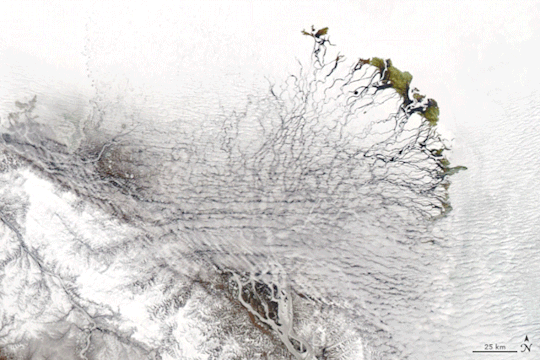
For most of the year, the Lena River Delta—a vast wetland fanning out from northeast Siberia into the Arctic Ocean—is either frozen over and barren or thawed out and lush. Only briefly will you see it like this.
After seven months encased in snow and ice, the delta emerges for the short Arctic summer. The transition happens fast. The animation above, composed of images from the Moderate Resolution Imaging Spectroradiometer (MODIS) on our Aqua satellite, shows the transformation from June 3-10, 2019. Read more.
2020: Making Waves in the Andaman Sea

When tides, currents and gravity move water masses over seafloor features, they can create wave actions within the ocean. Oceanographers began studying these internal waves from ships in the 1960s, and the modern era of satellites has made it possible to see them on a grand scale. The Operational Land Imager (OLI) on Landsat 8 captured these images of the Andaman Sea on November 29, 2019. The reflection of the Sun on the ocean—sunglint—helps make the internal waves visible.
Internal waves form because the ocean is layered. Deep water tends to be colder, denser and saltier, while shallower water is often warmer, lighter and fresher. The differences in density and salinity cause layers of the ocean to behave like different fluids. When tides, currents, gravity and Earth’s rotation move these different water masses over seafloor formations (such as ridges or canyons), they create waves within the sea. Read more.
These images were taken from NASA Earth Observatory!
Interested in receiving Earth Observatory's Images of the Day? Subscribe to our newsletters or RSS feeds.
Make sure to follow us on Tumblr for your regular dose of space: http://nasa.tumblr.com.
#NASA#earth#earth science#mother earth#oceans#sea#seafloor#river#landscape#earth observatory#tides#Canada#blue marble#satellite images#celebration#tsauchab river#atlantic
1K notes
·
View notes
Text
Reimagining ATLA's Water Tribes and Air Nomads:
I love Avatar so much you guys, it's a masterpiece in writing and worldbuilding, but over the years I've sat and thought over it, I've thought up some ideas. In the show, the Air Nomads and Water Tribes aren't as fleshed out as the Fire Nation or Earth Kingdom, so as a worldbuilding exercise, I fleshed them out some more, with some slight rewriting.
The Water Tribes:
There are 2 types of Water Tribes - polar hunter-gatherer icebending tribes who developed waterbending as a result of being surrounded by ice and water(and use it to mass-hunt sea life and build ice houses, like the Arctic cultures they're based on), - and tropical seafarers who navigate a large ocean filled with islands, based on Austronesians and other Pacific peoples, who used ocean currents and star maps to navigate the vast oceans, and diverged into a number of different Pacific nations with the Austronesian expansion(being surrounded by a vast ocean, they'd develop waterbending separately than the poles).
The Pacific Water Tribe would have a large number of smaller "tribes" like how the polar tribes are divided into North and South, with some being inspired by Aboriginal Australians and Mississippians(hence boomerangs and other Oceanian influences in the polar Water Tribe, and also the swamp tribe), and as the Fire Nation is a tropical island nation that colonized nearby coastal territories, a number of these Water Tribes will be colonized by the Fire Nation, similar to the Earth kingdom, some of the earliest colonies in the Fire Nation's expansion.
Given both of their cultures have the shared art of waterbending(and more recently, both being colonized by the Fire Nation), the polar and tropical tribes have a kinship with each other, and welcome other Water Tribe people and assist them in their voyages(better explaining how polar tribes can cross the entire earth from pole to pole, going through vastly different climates, in ships made from just bone and animal hide). Given Water is the element of change and adaptability (a large number of tribes united by a common bending style developed in different occasions to suit their environment) and heart and community (resisting the Fire Nation and cultural camaraderie and hospitality to other Tribespeople even if they aren't a part of your tribe, along with the theme of indigenous unity forming in the wake of colonization, which could be tied to the element of Water), these would fit pretty in line with what Water represents in Avatar.
Sokka and Katara would meet other Water Tribes and the people that make them up in Book 1 as they travel from pole to pole, and learn about things like seafaring by sensing the ocean and looking to the moon's astral companions, along with have small bits of community and hospitality when they enter Water Tribe territories along their way. There would be a recurring character a la Jet or Suki from one of these new tribes.
Lastly, in real life, day and night cycles behave very differently in polar regions: at the poles of the earth, an entire year is 6 months of darkness and night, followed by the sun rising and not setting for another 6 months. This is called the midnight sun effect(and is something Sokka actually references in the first episode of the series, despite the sun and moon rising and setting in normal 24 hour cycles in the show). Given how Waterbending and Firebending are given strength by the sun and moon, this would be a great detail to add to Book 1, perhaps with the eventual sunrise/set in the Northern Water Tribe being a timeframe they need to reach the tribe before it occurs, as it would be such an important event.
Also, as mentioned in a previous post I made, I like the idea of the spirit portals on each pole being connected, and how the Polar Water Tribes became 'sister tribes' before they could circumnavigate the globe, along with how the Ocean and Moon spirit moved between the North and South Water Tribes on a cycle, before the Fire Nation severed the portal with the spiritual wound they inflicted on the world with their genocide of the Air Nomads and Southern Water Tribe, a visualization of the spiritual damage they are doing on the world, and one that would eventually heal decades later in Korra's era after reparations are made.
The Air Nomads:
The Air Nomads were not wiped out entirely in Sozin's genocide - Aang is not the last person of his culture. In real life, genocides do not destroy a culture or people entirely - they are still alive, often with their culture critically endangered and their presence erased and suppressed so that many people do not think they even exist anymore, see how Americans treat the original inhabitants of our continents that White Europeans tried to wipe out(and never fully succeeded in). I didn't mind the Air Nomads being revived and Sky Bisons miraculously surviving in Korra for this reason, a more realistic tragedy for Aang(aside from having ran away and not been able to interfere when the genocide of his people started and losing all his friends and family over the 100 year time skip) would be dealing with the actual effects of genocide and being a member of a culture that the Fire Nation drove to endangerment and is deeply wounded and scarred from a systemic genocide against them.
Aang would meet other Air Nomads, and we'd get a character who was an Air Nomad too, possibly showing the cultural differences between the 4 temples(which don't have that weird worldbuilding about gender segregation, also, not every Air Nomad would be an Airbender like the creators have stated). This would also help explain why the Sandbenders knew what specialized equipment to use to capture Appa when airbenders and sky bisons haven't existed for 100 years, and how Long Feng and other Earth Kingdom people knew about Sky Bisons, with an Earth Kingdom commoner saying Appa was probably being sold for bison steaks(a market that apparently still existed 100 years after Bisons were driven extinct).
I'd want to see how Air Nomads who couldn't airbend would be accommodated in their culture - every kin group can still have a flying bison and make their nomadic travels, but how are non-benders accommodated? This could connect to the inventor's son in the Northern Air Temple, who showed how disabled people could have accomodations made for them in gliders. Maybe the Western Air Temple could be a little more OSHA compliant, so you wouldn't fall to your death if you trip near a ledge, too.
I feel like we didn't get to see enough of the Air Nomads in ATLA, after Gyatso and Aang, is the only other named Air Nomad Yangchen, who appears like twice throughout the original show? I'd love to see Air Nomads migrating and raising herds of bison(they are nomadic pastoralists, after all). Tibetan culture has a unique element where many young boys are expected to live at a monastery for a few years to learn discipline and mature, which would be interesting to represent in the Air Nomads' spirituality and temples that are already present in the show. Would there be any Air Nomad settlements or homesteads outside the Air Temples? Would there be many nomadic herds of bison herders in the mountains and islands the temples are situated in?
Lastly, Air Nomads surviving the genocide would heighten ATLA's important message about reparations and healing from genocide and violence: after the Fire Nation is de-programmed and reparations are made to restore and help the Air Nomads and Water Tribes heal, the sky bisons will return to roaming the world, and the Air Nomads would be able to rebuild their culture and the Water Tribes would be able to rebuild their tribes and regain autonomy of their territory when the Fire Nation returns their land to them, with the spiritual scars left on the world after the Fire Nation's war eventually healing, with the portals in the Water Tribe being restored again and the Ocean and Moon spirits being able to return to the Southern Water Tribe's spirit oasis again after years of being severed from them.
#avatar#avatar the last airbender#sokka#katara#aang#worldbuilding#rewrite#atla#air nomads#water tribe
35 notes
·
View notes
Text
Lost Kingdom - Re-Review #34

“Lesson over.”
And once again, Kayo is seemingly perfect... @tsarinatorment and @psychoseal is it time for some more rants? I think so. I’m sure Tin-Tin would have been quite capable at holding her own in TOS, and I also think Gordon would be a little better at physical combat. But hey, this is only like forty seconds of the episode, so I will move on.
“I wonder if Kayo’s finally met her match.”
“Guess not.”
Just to say, I was so voting for MAX - seriously, I have faith in this robot. Does no one remember him in ‘Legacy’? I’d have MAX for a guard dog any day.
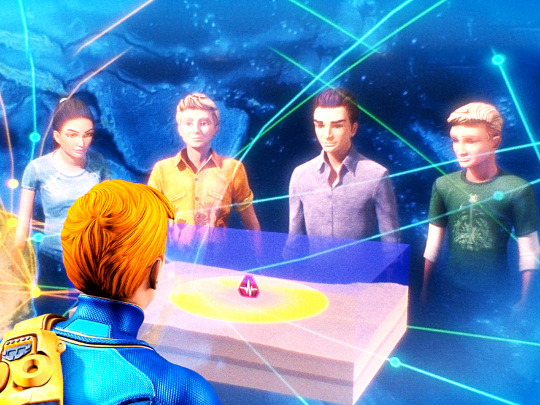
“I’m detecting structures down there. They seem to be man made.”
“Want me to get Virgil?”
Why, Alan? So he can go in and do some heavy lifting? In fairness, there had to be some kind of reference to him because um... where is he? Anyone want to hazard a guess?
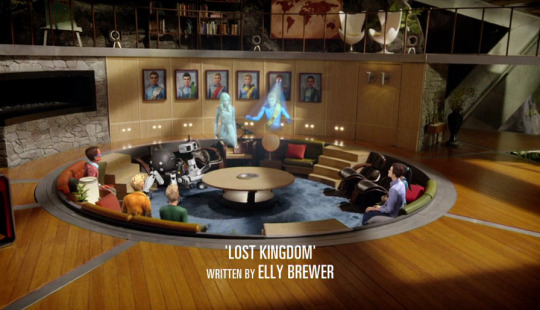
“The World Council Emergency conference just ended, and the archaeologists agree, it is the lost city of Atlantis.”
“Imagine that. A city reappearing after thousand and thousands of years.”
“If it’s been buried under water for that long... there won’t be much left that’s worth seeing.”
Oh my gosh, I love the story of Atlantis! Literally, other than animal conservation, Ancient/Classical History was one of my favourite topics.
Anyone else love this film? Apparently it’s one of the most loved Disney films, but also most forgotten. Bit of trivia for you as well - it was the only Disney film to have ten proposed DVD covers, all of which were released as promotional posters, but of course only one made it onto the DVD. However, the German and Chinese distributors for the DVD chose to use different posters for the DVD cover (both of which only saw distribution in these countries) whilst the rest of the world copied the British/American choice. Personally, I preferred every other poster to the one they used the DVD, but hey, they didn’t give me a vote.
And, okay, yes, I won’t admit to knowing everything, but I do know a lot about what other people might class as pointless.
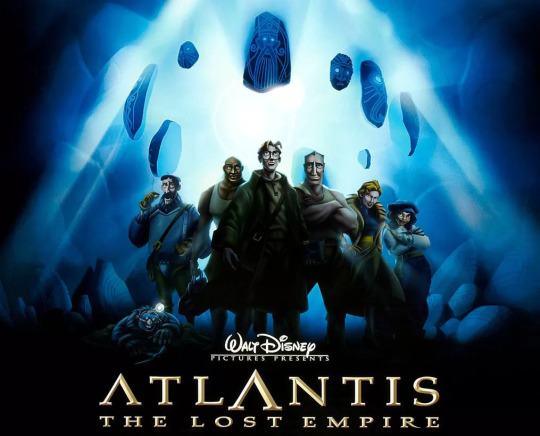
Anyhow, back to Thunderbirds;
“I’ve got a feed coming in. You need to see this.”
“This is Francios Lemaire, bringing you lucky viewers, yet another chance to watch me make history! And here we are, on the bridge-”
“Control room.”
“Control room- of my luxury sub, the Jules Verne, from where I’ll be bringing you footage, of the very first human - that’s me - to explore the legendary, lost city of Atlantis!”
Oh look, here we go!
As soon as that music started I just who it was going to be.
Madeline is perfectly describing my feelings on Francois for this episode in this picture. I think - by the look of the faces we got from Tracy Island - that she describes what the Tracy boys feel as well.

“I order you to leave the area.”
Yeah, Lady Penelope, you tell him.
“Alright, alright, I was only trying to bring a bit of culture to the masses.”
Probably not the right way to do it.
“Your submarine’s in a live sea quake zone, Mr Lemaire, I strongly advise you to leave as fast as you can.”
“What is this? The International Rescue Babysitting Service!”
Um... considering your past record... yes?
Anyone remember the birthday party in the Mariana trench?
“I’m well aware of my location, thank you.”
Um, was he drinking whilst driving? Yeah, that’s a great thing to teach the masses.
“Francois, that’s re... uh.”
“Oh dear. Silly goose. Why didn’t you tell me I was in the wrong gear?”
Probably why you got the wrong gear, mate... Time to call the International Rescue Babysitting Service, d’you think, Lemaire?
So, anyhow, thanks to Lemaire’s stupidity - we have a rescue! And it’s one for Gordon - the water kind of gave that away - and oh look, Virgil (wordlessly) runs across the scene and gets ready to go. Really, where was he?
Still, I think I would have lost my patience with Lemaire by now - and damn ethics, I might have been tempted to ignore him.
“Hello, how much longer do I have to wait?”
“It’s only been half an hour.”
“I’m bored.”
“Patching you through to Thunderbird Two for an update.”
Ha-ha, way to pass Lemaire away from you John!
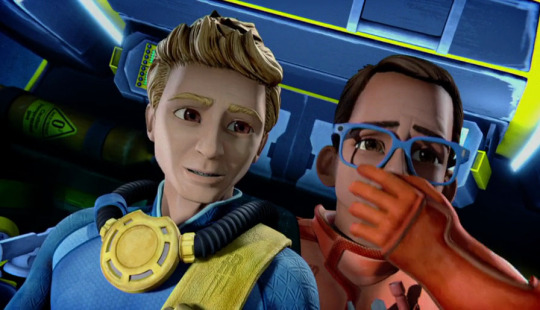
“We’re coming too!”
I can hardly believe it! It’s Brains, willingly going on a rescue, in person!
“I’ll tell you what’s crazy, Brains. Us chasing Lemaire through an active sea quake zone!”
Why is that man such an idiot? He really didn’t even need IR. Next time definitely just leave him, I vote.
“It’s breathable air.”
“It better be, look!”
And Lemaire’s idiotic streak increases...

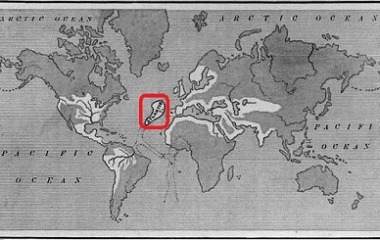
So, here we are - apparently. There are many proposed locations for Atlantis (the first map below is Europe, the second is a wider view of the world), with many still in dispute. For a long time, it was believed that Atlantis being near Santorini made sense. In fairness, when I stayed in Crete, I had a lovely tour with some locals who tried to show me all the reasons why Atlantis had been near them. Actually, their argument (especially in their native language without the typical English mis-translations) is quite convincing. Crete does have massively similar architecture to that suggested in the Ancient Greek depictions of Altantis. It was argued that these could have been built at a much later stage, but the stone dates back far enough to suggest not. Whether or not Atlantis did sit near Crete, it is fair to say (especially as both were inhabited by the Greeks) that maybe the Atlantians did have a part of their Empire there.
Later, theories rose that Atlantis had previously filled a gap in the Straits of Gibraltar, and Island separating Spain and Africa, and potentially offering connections between continents. This was initially met with much annoyance by Greeks, who believed that Atlantis (an ancient Greek Empire) couldn’t have sat so far away from their own homelands. But, at the time, it was really only Greek and Italy who had big plays across Europe, and the Atlantians were rumoured to have waged war or conquered a considerable amount of the country in Greek’s name. The Straits also make a lot of sense scientifically and geographically. Although the Greeks believed (at the time and still now) Poseidon to be responsible for the sinking of Atlantis, we know that it had to have been a combination of earthquakes and/or tsunami’s which brought down this great empire, and the Straits of Gibraltar sit directly on a tectonic fault line which has led to a subduction zone (so sea quakes would be of great possibility - so I’m assuming TAG have gone with Gibraltar as a setting here) which has now been active (that we know of) from the 1700s - seems likely to be it was active before too.
You can read more about that here if it is of interest to you: https://www.livescience.com/19656-gibraltar-subduction-zone.html
Of course, many take the belief that Atlantis was a fictional story of Plato’s, whilst other’s take the belief that it was the end of the ‘last great ice age’ which caused the disappearance of Atlantis (due to flooding, sounding familiar?), but Plato’s descriptions, whether believed or not does suggest that Atlantis built connections between Africa and Europe (later working into the Pangea theories) and that the sea delves further than we know;
“In the Atlantic there was an island, larger than Libya and Asia put together, and was the way to other islands, and from these you might pass to the whole of the opposite continent which surrounded the true ocean; for this sea which is within the Straits of Heracles is only a harbour, and the surrounding land may be most truly called a boundless continent. Now in this island of Atlantis there was a great and wonderful empire which had rule over the whole island and several others, and over parts of the continent. She was pre-eminent in courage and military skill, and was the leader of the Hellenes. And when the rest fell off from her, being compelled to stand alone, after having undergone the very extremity of danger, she defeated and triumphed over the invaders, and preserved from slavery those who were not yet subjugated, and generously liberated all the rest of us who dwell within the pillars. But afterwards there occurred violent earthquakes and floods; and in a single day and night of misfortune all your warlike men in a body sank into the earth, and the island of Atlantis in like manner disappeared in the depths of the sea. For which reason the sea in those parts is impassable and impenetrable; and this was caused by the subsidence of the island. ”
Plato’s final passage on Atlantis, as it sits translated from direct Greek (thus ignore any tense errors - they are intended).
Plato’s impenetrable and impassable ocean theory would fit with the territory of high seismic activity too - which does suggest Gibraltar as a decent proposal, especially as Plato seems to know the Straits by another name, but the same land mass.
Okay, I’ve now ranted on about Ancient history enough, I think (although it is another reason why I love this episode), and I honestly do still have such a soft spot for the history of Atlantis. Maybe one day I’ll change careers and become a historian, but for now I’m happy with my mission of trying to limit extinction and global disasters. If anyone wants any more knowledge on Atlantis, just ask and I’ll put it in a separate post - this one is going to be too long otherwise, and is meant to be about something else.
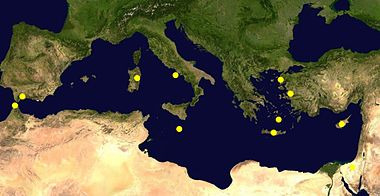
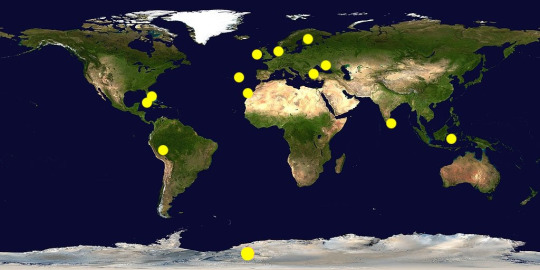
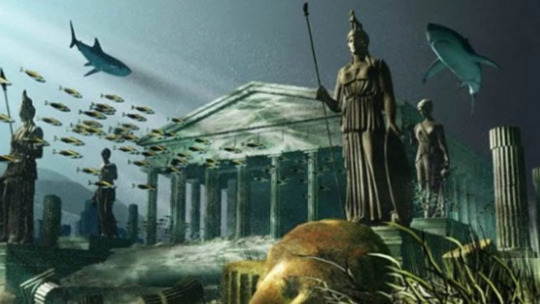
You can definitely see where they took their inspiration from. I seriously adored all the behind the scenes footage for this episode. Go and look at it for yourself, the detail they put into it all makes it worth it.
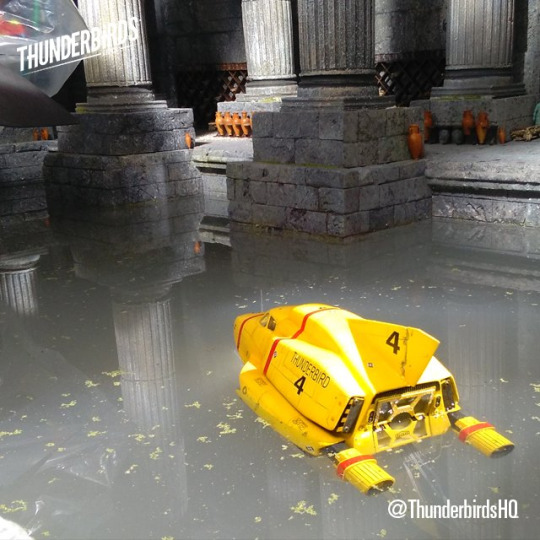
“Look at those shapes. This was definitely built by Mer-people! Start rolling. I’ll do a piece to camera.”
“You grabbed me, we ran. I don’t have the camera with me. And we shouldn’t be in here!”
“Mr Lemaire, you’re putting yourself and your wife in danger!”
Yeah, I don’t think he really cares Gordon, she’s just his glamorous assistant and biographer after all - wife is actually quite far down the list.
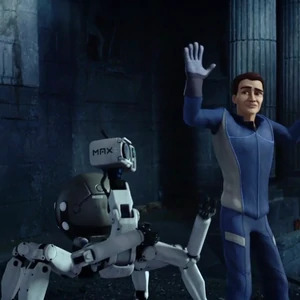
“Would you order MAX to assist Mr Lemaire from the area?”
“That won’t be necessary!”
Scared of a robot, are we now, Lemaire?
See, just saying MAX could have totally taken Kayo. In my opinion.
“We’re trapped and Thunderbird Four is on the other side. Is it still in one piece?”
“I’m picking up full readings.”
Hell, it better be! You only just rebuilt it in the last episode! Goodness, imagine that all over again.
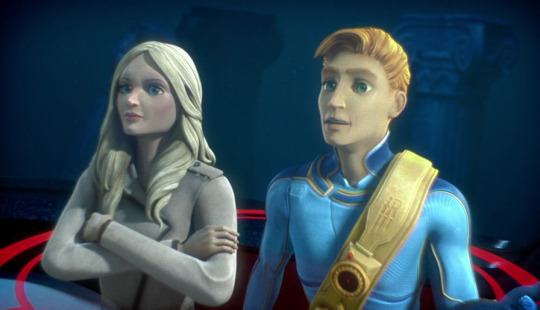
“Hello Gordon.”
“Lady Penelope!”
“Aren’t you lucky that I was around to come and dig you out of trouble.”
“I’m even happy to be rescued by a Lady in a pink submarine if it gets me away from Lemaire.”
So don’t go knocking it Gordon! She could easily turn around, you know. And just say you’re happy to see her, Gordon! Goodness these two could have been together long ago if they weren’t both so stubborn (and Gordon a little silly).
“He is one royal pain in the-”
Language! You’re talking to a Lady (and an audience group consisting of children), Gordon! I think we can all agree with the proposed end of that sentence though. Lemaire is.
“Do not fire a missile at my submarine!”
Yeah... point proven, again, I think.
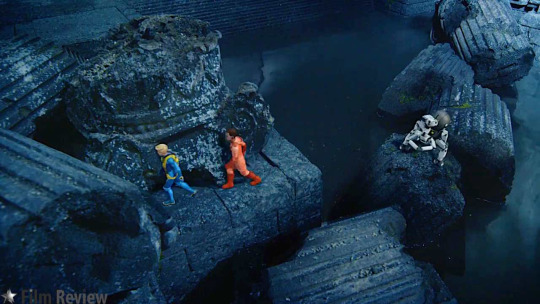
“Final proof that Mer-people exist!”
Did anyone mention yet that meeting a mermaid is Gordon’s dream? Just because, he doesn’t seem too excited about that prospect here. Brains on the other hand, he can die a happy man now.
“We’re going to rebuild it in the assembly hanger, full scale!”
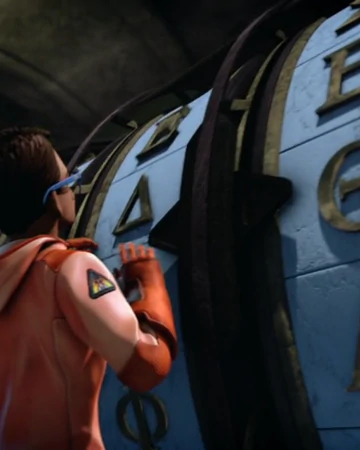
Nice reference to the selfie-stick in this episode, which was at the time, brand new, of course. I am still bitter that said word has made it into the Oxford Dictionary - seriously, they dropped the level of the game by letting that in.
“Parker loves playing pinball, don’t you Parker?”
“Not when hI’m the ball, M’Lady.”
We’re really learning a lot about Parker’s free time lately - pinball and complaining about the weather... hmm, interesting.
It was a nice way to end - showing everyone going out to the pool - good to see them making use of that thing!
#Thunderbirds are go#Lost Kingdom#Re-Review series#Darkestwolfx#John Tracy#Gordon Tracy#Lady Penelope#Parker#Brains#MAX#Francois Lemaire#Atlantis#CITV#ITV#TAG#scott tracy#virgil tracy#Alan Tracy#Kayo#Thunderbird Four#Thunderbird Five#Behind the scenes#lost city#atlantis the lost empire#straits of gibraltar
15 notes
·
View notes
Text
#15: 幕末降臨伝ONI / Bakumatsu Kourinden ONI

Bakumatsu Kourinden ONI is a direct sequel to Kishin Kourinden ONI, released around 2 years after the latter. Bakumatsu is an upgrade to its predecessor in many respects, and is definitely the stronger game of the two, but some baffling design decisions are present, including ones it shares its with predecessor. Set in the Bakumatsu period of Japan, an era where the shogun's influence over the rulings of the country would come to an end, we play as a group of monster-hunters working for the Shadow Shinsengumi - a secret police dedicated to protecting the country from all sorts of beasties. Our main man is Yamatomaru - originally from a small village, he would attract the Shinsengumi's attention after saving some of the village children from winding up as monster-food. Brash, foul-mouthed, and good-hearted, he is essence of a typical shounen-style hero.

After being soundly defeated by a monster seeking revenge for his slain friend in his hometown, our hero is saved by the enigmatic Jurouta, who invites the young boy into the shogun's service, stating that he has the proper qualities of a monster hunter. Initially reluctant, Yamatomaru, determined to become a strong warrior like his deceased father, meets up with the handsome man and accepts the offer. As more and more monster related incidents occur. it becomes clear that certain hot-spots of spiritual energy, what the came calls "spirit pits", are going haywire, giving rise to all sorts of calamities within Japan. Furthermore, a mysterious foreigner with dubious intentions, Riche, is also seeking out the spirit pits, and is willing to do anything to obtain control of them.
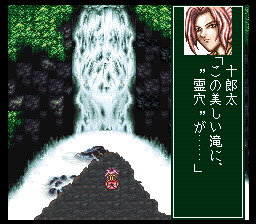
Our heroic twosome is soon blessed with the addition of the Saigami siblings: Natsume and Touya. The Saigami clan is reknowned for their spiritual prowess - including the ability to seal away the raging pits. Natsume is deeply insecure in her own power, however, and for the first half of the game, the party heavily leans on Touya to do what is needed. We are later in the game joined by Squanto - the former leader of a ruined nation due to Riche's machinations. A man of few words, he is a solid tank of a character, dedicated to defeating the colonizers that ruined his way of life.

As charming as this cast is, I felt that, outside of their initial introductions, the game doesn't bother to develop the cast much. Yamatomaru begins the game as a hot-headed himbo, and shows little growth throughout the story. Jurouta is the same, save for the revelation that he is actually a she, causing Natsume to question her tastes when it comes to her love-life, as she is enamored with the stoic warrior. Touya is the typical over-protective brother to a T, but subverts this trope at the same time in an interesting way: instead of coddling his sister whenever she expresses insecurity about her abilities, he empowers her. He encourages her. It's very progressive, especially for a game of this age.
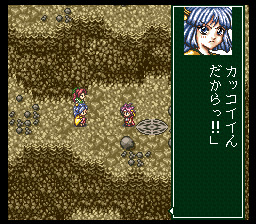
As one can see, the scope of Bakumatsu is much larger than the previous game, and overall, has a much darker tone. The story, at times, is relentlessly tragic: in one instance, you are forced to battle a former colleague of the Shadow Shinsengumi after he willingly transforms himself into a monster in order to prove himself - in another, you watch helplessly as an entire civilization is genocided off-screen. While Kishin wasn't afraid to showcase the occasional tragedy, it never goes as far as Bakumatsu. This is a dramatic game, and I commend the writers for going where others would not.

The narrative is focused: unlike the vignette-heavy style of Kishin, Bakumatsu is fast-paced and dynamic - allegiances shift at a breakneck pace, and as soon as one threat is vanquished, another rises to take its place. It feels exciting to play. The dungeons are, for the most part, short and snappy. I remember the dungeons in Kishin being an absolute chore at times, as the game would frequently chain multiple locations together with little plot to entice the player to continue on. While Bakumatsu does feature the occasional marathon sequence, the player is always provided with plenty of cut-scenes and opportunities to save and recover.

That being said, the game lacks in dungeon variety. Almost all of the dangerous places you'll visit in Bakumatsu are mountains, with only a color palette to differentiate them. It's boring. I found myself rushing through these levels, mashing the fast-forward button and avoiding thorough exploration. I understand the memory limits of the Super Famicom, but it still feels lazy. And while they are a definite disappointment, the rest of the graphic design in Bakumatsu excels. Your characters are superbly well-animated, full of personality and character. During the latter half of the game, your party travels across the sea to the New World - and it truly feels like a different continent! The level of detail in the map of a game this age managed to really surprise me, and I loved seeing my home country portrayed through the eyes of a different culture than my own.
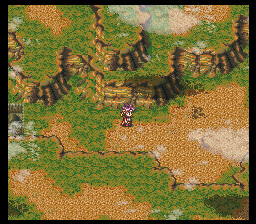
Bakumatsu features an upgraded combat system. Each character has a variety of sword-techniques that use their own MP gauge which is restored by walking. They're are all super well-animated, flashy, and just plain cool. Even the most basic moves are stronger than your standard attack, so even the ones you acquire early on retain their usefulness throughout the entire game. The standard magic spells and summon abilities have been upgraded graphically, too, making the battle sequences, as a whole, feel much more exciting and dynamic.
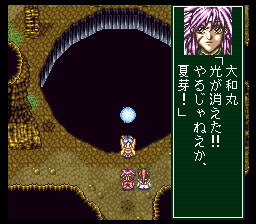
Which is great, because like its predecessor, the encounter rate in Bakumatsu is disrespectful. Battles occur every couple of steps, and enemies are, due to the expanded combat mechanics in comparison to the previous game, often take a bit longer to defeat, as they tend to have an immunity to either magic or physical attacks. Remembering these characteristics is a matter of memory, as there are no spells available to identify weaknesses. Despite this, the overall difficulty level in Bakumatsu is much more reasonable than in Kishin - there are only two instances in which I had to stop and grind out some levels: once in the very beginning, and another near the very end of the game.
There are two other types of encounters that are worth discussing: the ship battles, and the underwater battles. Once you acquire your ship, you will, at times, run into other sailors that want nothing more than to send you to a watery grave. Your ship functions as a character would - it gains experience and levels up as you defeat enemies, but you must spend a pretty penny at the Yokohama docks for it to be upgraded. These oceanic encounters are novel for their time, and amusing enough, but suffer from balance issues. The first time you embark out onto the sea, you will have no way of knowing which ships you can take on, and which ones you have no chance against. It's a matter of trial-and-error, so frequent saving is recommended.

The underwater battles are similar to regular encounters, but special attacks and spells are disabled, and are instead replaced with a bar that represents how much time you can stay underwater. Should this meter run out, your character dies instantly. Taking damage and attacking foes decreases this meter, but you can choose to surface for air, but doing so will end your character's turn. This presents an interesting "risk and reward" system - the player has to choose whether or not to risk drowning or finishing a battle quickly. I wish spells were available, though. I feel as though it would have been easy enough for the developer's to disable fire and water attacks, leaving the earth and other elements. Some of the monsters you'll find underneath the water's surface are vicious. I've never been more afraid of crabs in my entire life!

Like it's predecessor, there is plenty of side-content to discover throughout the world, including a village-building minigame. Inhabited by friendly monsters you found throughout Japan, you can earn various rewards as it develops into a bustling hamlet. Special summons can also be found, but you'll have to meet special conditions in order for them to lend you their aid. This is where Bakumatsu’s most intriguing aspect comes into the play: the karma system. Depending on your choices throughout the game, you'll be assigned a rank, ranging from "Absolute Villain" to "Godlike" - these can affect whether or not you'll be able to obtain certain allies or spells. Unfortunately, once you reach a certain point in the game, it becomes impossible to influence your rank beyond a certain point. If you're aiming to obtain everything, I'd recommend a guide.

There is a lot to like about Bakumatsu: the game is well-paced, graphically stunning, and I loved how the developers were unafraid to experiment with all sorts of different mechanics. While the execution of these ideas were occasionally lacking, they were novel for their time. Between Bakumatsu and Kishin, if you were to only play one, I'd definitely recommend this title. It's a solid, if occasionally frustrating, experience, dripping with style and visual flair. Definitely recommend!
#retrogaming#retro gaming#super famicom#super nintendo#oni series#bakumatsu kourinden oni#game review#rpg#jrpg#gaymer
2 notes
·
View notes
Text
RWBY timeline
The show doesn’t give us too much reference for how much time has passed in-show, but we do get some indications throughout the show so i’m gonna try and lay them out (and line up some things roughly that were happening around the same time). i’m gonna break things up into seasons as we’re never given specific dates and one of our key frames of reference is gonna be Ruby’s age, as she’s introduced to us in the Red trailer at age 15, and we now know through Chibi that her birthday is the 31st of October, and from there we can roughly map out when everything takes place
everything else under the cut because obviously this got looong
~80AGW
okay so we know the Vytal Festival is held once every two years and has done since the end of the Great War, with the year the series starts being one of those years, and we’re told it’s the 40th Festival since it’s inception, so lets call this year 80AGW (After the Great War)
Winter
so we’ll start at the start - the winter of this year
only a few things happen here, namely the Red trailer/its manga adaptation by Miwa and presumably Weiss’s training with Winter in the flashback segments of the Weiss Character Short (but it’s Atlas so it could be later). the White trailer/its manga adaptation by Miwa could also potentially happen here
Spring
quite a lot happens here - so its best to bullet point from here out
White trailer/Miwa manga chapters 3 & 4 - time of year unclear, may be set not long before the start of school year as the purpose of the fight is Jacques (or rather his secretary) ‘testing’ Weiss, intending that she lose so she’ll go to Atlas Academy where Jacques can still have control over her, instead of Beacon, where she wants to go
Black trailer/Miwa manga chapters 5 & 6 - set at the same time as the flashback in 3x07 and the flashback of Blake’s V5 Character Short (that it’s set in Forever Fall doesn’t help, though 3x07 helps suggests it’s not winter and could be early spring)
Yang V5 Character Short - Yang mentions she’ll be starting at Beacon 'soon’ but evidently the two are still under the impression that Ruby will be staying at Signal this year. seems to be set around spring time
Yellow trailer/Miwa manga chapters 7, 8 & 9 - not long prior to 1x01 (as we see Roman hiring Junior’s thugs)
1x01 - not long after Yellow trailer, implied to not be very long before beginning of the semester
the assumption that these all take place in Spring is based on that during the school year we see, several months do pass and it ends in Autumn/Fall (though still before the end of October, we’ll get to that), so Spring is what makes the most sense here. now we get into the Semesters - the first semester seems to span Spring-Summer given the very temperate weather we see in Vale during this time
- Semester 1 (spring - summer)
Volume 1 - starts not long after the main events of 1x01. takes place over most of the course of this semester (episodes 2-10 being the first three days, then skipping some time further). within this, the non-Red trailer parts of manga chapters 1/2 occur, happening sometime not long after 1x10, detailing an event of Jaune getting bullied by Cardin, and Ruby fighting in the training arena for the first time (there’s a slight retcon with Ruby only deciding to wear her hood over her uniform after this event)
Summer
this semester takes place over a few months - this is when the preparations for the Vytal festival begin, and exchange students begin arriving, Ruby comments that it’s been “a few months” since she ran into Torchwick in 1x15
this episode also gives us a sense that the semesters at the other academies must occur in parallel with each other, as Cinder makes her reappearance, along with Emerald and Mercury, at the end of volume 1. we learn in volume 5 that they used Lionheart to get entrance into the tournament, and as the Haven students would notice a team they’d never met before representing them, the implication is that the posing as students was happening at Haven itself before they arrived back in Vale - this also serves as an explanation for why Cinder wasn’t directly involved in volume 1 and an in-universe explanation for why Neo wasn’t around to help Roman out, because she was the fourth teammate (and being used as blackmail against Roman no doubt) - this will be important later
a short time after 1x16, we get the flashforward at the end of chapter 6 of the Miwa manga, with Blake waking up having dreamed the events of the Black trailer and Yang getting extreme cuteness proximity over Blake’s ears
at some point following this, chapters 10-15 of the Miwa manga occur, depicting a training mission set after 1x16 (evidenced by Penny’s appearance, mention of her having been 'influenced’ by something - implied to be Ruby - and Roman scouting out the tunnels he will eventually be moving his operation into under Cinder’s orders); RWBY and JNPR fight a Grimm that fuses together 4 King Taijitu into a hydra-esque monster; said Grimm was originally living in the tunnels leading to Mountain Glenn’s undercity, and was accidentally released by Roman
- Semester 2 (summer-autumn/fall)
when the show resumed in volume 2, we’re told there’s been a minimum of a two week break since the last semester ended (Ruby mentions that “the last two weeks have been great” but that might not necessarily have been their entire holiday, for all we know Ruby and Yang went home to visit their dad)
2x01 starts the day before semester 2 starts, Ruby mentions that the tournament marking the end of the Vytal festival is at “the end of the year” as preface for how “our second semester is going to be great!”. this establishes that volumes 2 and 3 occur within the same semester (and this is going to be important later), and while yeah, there’s a season change, we know from volume 1 that semesters span ‘months’ (which does make it seem like there’s a two long semester school year and then they have winter off)
Volume 2 has a much more contained timeframe compared to volume 1, taking place over the course of a couple of weeks and Vytal festivities beginning, starting with the dance prior to first year students beginning to take on real missions around the Kingdom - it’s unclear if classes are still in session after this point for First Years (as higher year groups like CFVY are already on missions before this point)
Grimm Eclipse takes place somewhere between volumes 2 and 3, and lasts a couple of days, detailing another mission team RWBY took on (JNPR are DLC for the game, so their presence isn’t canon) against the mutant Grimm created by Dr Merlot, who also had a big hand in the destruction of Mountain Glenn (i’m just adding flavour text at this point)
Autumn/’Fall’
volume 3 wastes no time in establishing that we’re now in the tail end of the year - the leaves have turned, they’re falling, we get mention that the weather has gotten colder right before Ruby establishes that it is fall at this point
we also know that it’s happening before the end of October, as Ciel gives Ruby’s age in her profile of her and mentions that she’s 15 (and Ruby doesn’t move to correct her on that)
the volume itself is very tightly contained, with most of it taking place over the course of about 5 days (i’m gonna be using episodes as reference points but there’s some overlap)
- Day 1, 3x01 - 3x03: RWBY vs ABRN, JNPR vs BRNZ and SSSN vs NDGO and Winter arriving and Qrow causing a ruckus all happening on the same day (this also establishes that Qrow’s been on mission since at least before the volume 1 finale, as we got his message about Salem having pawns way back in 1x16)
- Day 2, 3x04: Takes place the next day, depicting the first of the doubles rounds EM vs CY, Qrow’s talk with Yang and Ruby and Winter’s talk with Weiss, and ending as Winter leaves
- Day 3, 3x05: next day, PC vs CD, WY vs FN, Cinder finds out about Penny (it’s dark outside the window in this scene compared to the next scene which is still late afternoon)
- Day 4, 3x06 - 3x07: Pyrrha gets her entire reality shattered, Yang vs Mercury later in the evening and how that all ended up
- Day 5, 3x08 - 3x12 (pre-timeskip): literally everything else happens in the same day
Ruby wakes up from her silver-eyes induced coma, implied to be a few days later
Winter
there’s a time skip in 3x12 that jumps to wintertime, when Ruby leaves with JNR to go to Haven, following Qrow’s tipoff. this means that Ruby is 16 from this point on - and she visits Summer’s grave, creating a bookend with the Red trailer. it’s unclear when exactly she left, it could’ve been December, it could’ve been as late as February, we don’t know
~81AGW
Spring
Ruby’s volume 4 character short, which features a village on the outskirts of the Kingdom of Vale (confirmed by Kerry) being attacked by Grimm, Ruby notices and goes in to clear the place - this is the earliest confirmed point in the second year of the show (as the winter sections of the volume 3 finale could still be happening in the first year, we got no clarification) but probably not too long after the volume 3 finale (although long enough for the snow to have melted) given how RNJR are still in Vale at this point, they hadn’t even left the Kingdom let alone the continent
now before we get to Summer, i just wanna point out a few things about the synchronicity of the arcs for each character in volumes 4 and 5:
the events of volume 4 for each character are actually all pretty self-contained to a few weeks (because they don’t make sense if they spanned any longer), they’re just not in sync with each other (though Yang’s and Weiss’s are close), and all appear to end not long before each character’s start in volume 5
Blake starts volume 4 having only just recently gotten on to the ship to Menagerie - it seems to be spring/summer time, given that she’s already dressed for warmer weather (and this arc ends not long before the 'present’ sections of her character short and the beginning of her section in volume 5, which is two months before the start of the Fall Semester at Haven, which further suggests summer time) and her abilities have evidently taken a leap - it’s possible the reason it’s taken so long for her to leave the continent is she’d been traveling to the eastern side of the continent on foot and then got on a ship there, which’d explain the advancement in her abilities and the necessity for the new outfit. Blake’s arc is, however, a few weeks ahead of everyone elses, with things wrapping up in Menagerie two weeks before the events at Haven which the other protags were only a few days away from
Summer
Ruby and JNR’s story starts with 4x01, where they’re helping out another village (so likely summer time, as this arc ends with them getting a lift to Mistral and Qrow recovering, with volume 5 starting not long after that, and that’s a month before the beginning of the Fall Semester)
Yang’s arc also seems to be summer time, again over the space of a few weeks (weeks are noted to have passed), and ends with a skip to her arriving in Anima, which can’t be too long before her appearance in volume 5 (which is a few weeks after 5x01 for Ruby and JNR, as Oscar notes having had the cane for 'a few weeks’ before Yang and Weiss arrive)
as mentioned Weiss’s arc was more or less parallel to Yang’s, seeming to take place over a few weeks and ending not long before where she was at the beginning of volume 5 (and she can’t have been with the bandits too long before Yang showed up - they were planning on ransoming her and she was planning on breaking out with her summon)
In 5x01, Haven is noted to not be in session a month prior to the Fall semester starting. The commentary for this volume notes that they are between semesters at this point, not school-years, thus suggesting a month-long gap (at least) between semesters
While a month passes in Ruby’s timeline by the end of this volume, two days before the Fall semester, it still appears to be Summer time, as the leaves haven’t begun to turn (Mistral is in a similar east-west lateral line as Vale and a fairly temperate climate on a mountain, the effects of Autumn should have set in by this time) - this makes sense when you remember that the semesters of the Academy school years more or less line up with each other; so the Fall semester has to line up with Beacon’s second semester, which means the battle for Haven is taking place roughly a year after volume 2′s Best Day Ever
now we move on to our latest volume, volume 6
now despite the snowy setting, only two weeks have passed in-universe, as confirmed in 6x01. the reason for the sudden climate difference is that the heroes are going from the more temperate regions of Mistral to the colder, snowier parts of the continent in the north
this also places most of the events of the volume about a year after the dance arc - just for reference, we’re still a couple months out from Ruby’s 17th birthday at least (i know Lindsay’s said on two occasions that Ruby is now seventeen, but a couple of points against that; the timeline the show gives us doesn’t support it, it’s not direct word of god and both times Lindsay was answering a question quickly, which means it’s not great confirmation as it’s hard to answer accurately when you’re on a time limit or distracted and without reference materials to confirm it)
and it’s actually pretty easy to determine this, because here’s what Patch looked like in volume 3 Fall, prior to Ruby’s birthday
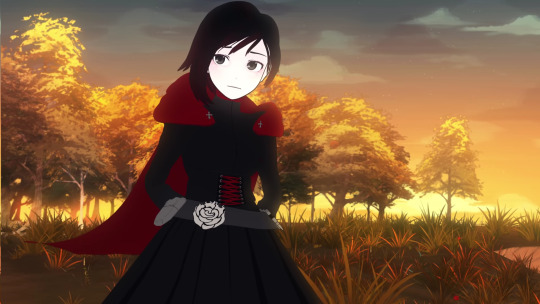
and here’s how Patch looks at the beginning of the Fall semester

these are very clearly not the same time of year
volume 6 itself has a case of the main plot taking place over about 4 days (day 1, everything from the Argus Limited to finding Brunswick farms, episodes 1-5. day 2, escaping Brunswick and arriving in Argus, episodes 6-7. day 3, trying to reason with Cordovin, JNR getting caught up with the plot and Oscar disappearing and getting a new outfit, episodes 8-10. day 4 - which could be a few days later, but not necessary - pretty much the rest of the volume and ending with arriving in Atlas that night) and then other plots going on at different times
- Adam’s slaughter of the remaining White Fang is some point in the two week time skip, as we see him with his new blindfold - it’s hard to see under the hood but you can see it - during the Argus Limited attack, presumably he just waited in Argus for Blake to show up again, as his appearance in 6x07 was a hallucination, as evidenced by his vol 1-3 outfit and mask
- Cinder arrives in Little Miss Malachite’s territory a month after the Battle of Haven, already a few weeks behind the team, and she’s attacked by and forms an alliance with Neo a week later. their progress involves trekking back to Haven and then stealing an airship, so it’s difficult to pinpoint where they are timelinewise right now
- everything with Salem and the other villains happens at some point in between these two events, as by process of elimination, Hazel was ‘the big guy’ asking after RWBY that Little Miss’s bodyguard mentioned having arrived a week prior - as this is pretty much the only way he’d know that Ozpin’s taking the lamp to Atlas
80 notes
·
View notes
Text
Thursday to Sunday, 26-29 August
Thursday
We had a leisurely start with a cooked brekky, but then packed up and were soon on the road again heading west and south towards the Bungle Bungles. It was an uneventful drive down and we were all set up on our site by about 3pm. Despite the drive being uneventful, it was still quite interesting. The scenery was great and varied and some of the nearby hills were quite spectacular. We drove through open grassland, scattered trees, wooded areas, and an interesting variety of rocky hills and grassy ranges, often quite close to the road. The variety of landscape, particularly the hills and rocks is quite wonderful, but it is one of those things that can’t really be described. You need to experience it. It is more than just the visual scene, the massive size and shape of the hills. It is also about the wonderment of how they came into being, thinking about their origins as liquid rock, hundreds or even thousands of metres underground, possibly a very long way from where they are now, with huge variations in the strata, the orientation, the permutations that have occurred over the thousands of millennia – it is all quite mind-boggling. I have very few landscape photos because I can’t take pics when I am driving – and I can’t keep stopping every kilometre or two to snap yet another gobsmacking hill, valley, tree, bird, or whatever. Heather takes lots of impromptu pics through the windscreen or from her side window and some of them end up on her blog or FB page. On the other hand, I see all the wonders she photographs, but I don’t get to record many of them – and sadly, even the best photos don’t even start to do justice to the scene. I am increasingly finding that looking at the beauty, or starkness, or whatever, evokes emotions of awe or wonder, amazement or pleasure: so many primeval feelings that somehow lock me into the history or origins of what I am looking at – and photos can never convey that.
It was hot – it has been in the high 30s for all of the past week or more – so it is much more comfortable in the car with the air conditioner on (or in the van if we have AC power) but I still went birding around the caravan park in the late afternoon. I didn’t see a lot, but just exploring and hoping to see something unusual is a lot of fun for me.
Friday
We visited the Bungle Bungles today. Four years ago, we flew around them, but today (and tomorrow), it is a ground level experience. The Visitors’ Centre is 52 kilometres from the caravan park over an atrocious track. The first 12-15 kilometres is not too bad, but from then on it is relentless corrugations, areas of horrific stony track that threaten to rip your tyres to pieces, six water crossings (longest probably only 50-60 metres and 450 centimetres deep so all very easy for our beast), but some stretches are all sharp bends, surprise dips, and steep blind crests, often very narrow and the driver needs 100% concentration all the time. We paid our fees and made a few purchases at the Visitors’ Centre and then headed north. There are basically two accessible areas to visit – one 19 kilometres north of the Visitors' Centre and the other 27 kilometres south – and we went north today and south tomorrow.
The roads inside the National Park are not much better than the track in, but we arrived at the Echidna Carpark within about two and a half hours of leaving the caravan. There are several walks at both the north and south areas, but given the heat, we limited ourselves to the less-challenging ones – after all, driving and even bouncing around in the passenger’s seat was challenging enough already.
We had been told that the best time to be in the Echidna Chasm was around 11.30 when the sun is directly overhead and lights up the chasm. We hurried in (a bit over a kilometre walk over very rough stones) and were rewarded with awe-inspiring colours and dramatic walls of rock. I will post some photos, but it is simply impossible to describe. I have no idea where the chasm ends, but we walked about a kilometre deep into the riven rock, sometimes less than a metre wide. At one point, Heather decided that the going was too hard, but I went a further few hundred metres with many more intrepid people still forging ahead of me before I turned back – for all I know, I might just have failed to reach the end by 50 metres or 50 kilometres!
We were probably in the Chasm for at least an hour and it was certainly cooler in there than out in the direct sun, but lunch and cold drinks beckoned so we headed back towards the carpark. There was a branch pathway to the Osmand Lookout not far from the carpark so we detoured there for more photos. (The range we photographed was the Osmand Range, hence the lookout's name.) We could have walked a few kilometres further to other lookouts and wonders beyond description, but we needed water and sustenance (and we are neither mad dogs nor Englishmen) so went back to the carpark and ate our lunch at one of the tables set up under a few big sails.
After lunch, we made our way back towards the Visitors’ Centre, stopping several times at lookouts and places of interest. At one place, we walked up to one lookout for photos and Heather decided to return to the car while I walked up to a second lookout in the opposite direction. Near the top of the hill, I became aware of at least 15 Spinifex Pigeons all around me. They rarely seem to fly, but just walk busily around, just out of arms’ reach, hiding in the spinifex – they are quite lovely. To me, the ones here appear quite a lot smaller and noticeably darker with less-vivid colouring that those we have seen before. Consulting my Australian Bird Guide, I noted that they are a different subspecies here, albeit not quite with the variations I have noted.
We stopped in another area where there is a walk with quite a bit of signage detailing the species of vegetation and describing how the aborigines used the plants for food, medicine, weapons and utensils. All very interesting and I was (as always) on the search for birds. I heard plenty in that area but saw almost none – sneaky little buggers, always hiding.
Then it was just a couple of hours hard driving back to the caravan park – and a wonderful cool shower.
Saturday
A partial repeat of yesterday – close to 2 hours to drive the 52 kilometres to the Visitors’ Centre, purchase our entrance fee and a couple more small souvenirs, and 27 kilometres hard driving south to the Piccaninny Carpark. We visited a couple of lookouts on the way and stopped for photos several times. At one place, our map and brochure blew out of the car, but we never realised it until several kilometres further on – so we back-tracked looking for it, without success. It wasn’t critical to have it, although it had lots of information that we may have wanted so it was a pity to lose it – but after giving up looking for it and heading back towards our destination, we actually found it on the side of the road. We had already driven past it without seeing it, but there it was.
There were two walks that we had decided to tackle – the Cathedral Gorge and the Domes – both very hot and exhausting. The track in to the Gorge was interesting, but was very hard going with a mix of thick heavy sand and rocky paths that scorched and bruised our feet. It was almost 2 kilometres in but well worth it. It was approached through another narrow gorge, a bit like a broader version of yesterday’s trek, but terminated in a mammoth cavern. As usual, there were several other groups there (it would have been magic to be there on our own, but obviously not practical) and the colours and structure of the place was quite overwhelming – almost impossible to take in. We were very hot by the time we got to the Cathedral so sat and cooled off for a while before trekking back out.
Closer to the carpark, there was a branch track to the Domes where one can walk through the archetypical beehive domes for which the area is so famous. Several hundred metres in, there were two confusing signs directing us in opposing directions, but a few walkers were coming out of the right-hand track and they explained that their track was a dead-end leading to another mini-cathedral. We decided to check it out and off we set, sweat pouring off us by this time. It was at least half a kilometre in but worth the walk, surrounded by rocky beehives and with some respite from the sun. Then it was the same walk back, hopping from one small shady spot to the next, and eventually taking the left-hand track that eventually threaded its way through several more beehives back to the carpark. It is hard to describe the splendour of this area (not the carpark, although even that is set among amazing colourful structures). It is unique, thought-provoking, beautiful, puzzling, awesome, inspiring, rugged – it goes on, but words are a poor way of hinting at the wonder of the place – and photos are not much better. It makes you think about the millions of years that went into creating the place. I was looking at one dome near the carpark while we were eating lunch. It had a mini-cave toward the top that looked as if a large boulder had rolled out of it and it started me wondering how many generations of aborigines looked at the same few square metres and wondered (as I did) what caused the formation to be exactly as it now is. Maybe that mini-cave was created last week – or maybe it was created millions of years before the first animal ever migrated to (or evolved) on the continent. We certainly live in an ancient, if not timeless, land. Totally wondrous.
Then it was back to the caravan park, completing 297 kilometres of really rough road in two days, but richer for having seen this unique part of the world. It is no wonder that it is a World Heritage Site – one of a kind and an experience never to be forgotten.
Sunday
We packed up slowly and set off on the journey south to Halls Creek – 106 kilometres and all on excellent bitumen and we were set up in the caravan park before lunch. There is very little shade in the park and in trying to take advantage of one small patch of occasional shade, I had to manoeuvre the van past another van that had a fold-up drying-line on the edge of the road – but no clothes on it. There was a big pile of sand on the other side of the roadway so the turn was tight and the back corner of the van grazed one arm of the drying line and tipped it over. Before I could even drive the 20 metres to where we were going to park, a ferocious-looking bikie-type guy rushed out and screamed abuse at me for wrecking their line and tearing down a tree in the process (we never actually touched the tree at all). Then, when I was squatting down disconnecting the van, he was back for another go, standing over me and threatening, still waving his clothes-line – all very unpleasant. He insists that the line was nowhere near the road but a closer inspection proved that it could not actually fit between his van and the road without at least half of it being on the road (as was his ladder, also at the back of his van). Sure, I shouldn’t have knocked the line over, but accidents happen and it was clearly not possible to get the van through with his line and the pile of sand on either side of the roadway. I just thought he over-reacted somewhat to a very minor infringement.
We spent most of the afternoon in the van, under the air conditioner, writing and sorting photos. We did a load of washing in between times and everything was dry within about an hour – it is very hot and dry here at present.
0 notes
Text
Meeting
Late dusk settled on the great city. Surroundings darkening as the long shadows of the buildings lengthened and the light dimmed. Matoran quickly returned to their hovels before their Metru’s curfew took full effect.
The Vahki continued on with their patrols between the living, droning on in the same set pattern that they had been repeating for the past month.
How boring.
She went from the dark alleyways, swiftly moving from shadow to shadow, avoiding both citizens and enforcers. Unseen, she made her way to the most important building in all of Metru Nui, the Coliseum. Making it to the outskirts of the monumental structure, she scanned the surroundings. Getting there was, of course, the easiest part, it was getting in that would require the hard work.
A whole pack of Vahki guarded the main entrance closely this evening. Great. She looked up at the towering coliseum, she really didn’t feel like scaling that tonight. The guards would need to get out of the way.
Unwavering, the Vahki stood their post, protecting the entrance fiercely from anyone without authorization. They stayed that way in their uniform silent alertness, poised and ready for slight altercation or unlawfulness that may occur. Then came the small yell, which pierced through the twilight air. Without hesitation, half the units from the group launched from their place, to locate the disturbance. Charging down the streets they detected it in a dead end alleyway close by, the culprit Matoran against the wall, a small knife sticking out of their shoulder. The Vahki were quick in apprehending the struggling citizen for violating the set curfew.
Now with what Vahki were left at the gate, she was able to slip by without issue. Once actually inside, things would be tricky. There would be Toa prowling on nearly every corner; odds were there may be a few with some Arthrons. Worst yet, if any Psionics Toa just happened to be in and around.
As always, her skills in stealth were of fine precision. She made it through the corridors, ducking and hiding when needed, working up the levels of the building one after the other. Eventually, finally, getting to the door she needed, she took some last few checks of her surroundings. At least this time it seemed that he bothered to keep the door unlocked. She went in, the door closing behind her without a sound.
The room was large, yet only one lightstone illuminated its interior, leaving many dark pockets and fringes of shadow around. So far, it appeared she was alone in this lived in accommodation. After getting all the way up here, she did not want to have to wait long…
Her heightened senses then abruptly caught the faint sounds of people walking and talking outside coming down the hall. Hastily she moved to the back out of any light. Their muffled vocals getting louder as they got closer, one distinct voice out of the two was immediately recognizable to her. They kept talking, their conversation becoming much clearer as they arrived at the door and opened it. In the doorway they both lingered, she listened closely to every word, to every detail they shared. Eventually the one she knew got impatient and shooed the other out; he shut the door just before his company could bid him a good night and locked it tight. The space returned to raw silence. He slowly turned around, there was only the two of them.
“Your drones are getting too repetitive,” Lariska spoke out as she stepped from the dark.
The green and silver armored Toa smirked. “Concern for the Vahki’s protocol patterns is well beneath me...I have larger issues to deal with.”
“It will become a larger issue when a resistance gets every schedule and pattern memorized.”
“Fine, I’ll mention something.” He walked forward, starting to close the distance between them before abruptly turning and stoping at a table with a recent re-annotated map spread out.
Already, Lariska could feel herself getting restless again. “You have anything for me?”
“Actually, I do,” The Toa of Air answered back as the hunter strode over next to him.
“Where?” She asked, looking down at the map.
He moved closer and leaned over her, pointing to a province on the northern continent. “The viceroy there is insisting that he doesn’t need the Toa around. He says he’ll still contribute to the empire, but feels that a bunch of us around is superficial and unnecessary.”
“And you want me to kill him?”
“No, no- not yet. Just scare and hurt him, let him have a taste of what it’s like without the Toa...In some cases it’s just easier to have them crawling back than look for a new one.”
The hunter was already contemplating what methods she’d be using. “When do you need me to leave?”
“As soon as possible,” he replied, when Lariska started to leave he promptly added. “-in the morning.”
She halted- of course he would do that again.
“I guess you're really not eager to have this job done.” Lariska turned back to him.
“Oh, I am,” Nidhiki smiled. “But it can wait a night.”
11 notes
·
View notes
Text
Helpful Sources for Fantasy Writers/Worldbuilders
As a fantasy writer myself, I have had to do for help in regards to building my world, whether that was guides on how to create your own fantasy names, making maps, or something as simple as questions to get you thinking in regards to building your world. I’m going to list a few of these resourceful links, to help other fantasy writers.
Mapmaking
While you don’t have to start right off with making a map, some writers prefer to do so, and others wait until they have a more concrete idea of what they want, either way, here are two websites that I feel have been a tremendous help to me.
Inkarnate
This is my preferred mapmaker of the two, and I speak as someone who cannot draw. Inkarnate also now offers a commercial license at a fee of $25 dollars a year.
Map Creator at Fantasy Name Generators
This one, is a mapmaker where you piece together your continents, it has many pieces and designs so that you can shape lands as you will. I have used this mapmaker, though I used an editing software at the end to place the multiple maps I had together and polish it up a bit. Good again for those who can’t draw.
And lastly, if you can draw, you can always make your own maps or hire someone to do a commission if you will.
Worldbuilding Guides
How many continents? What are the plate tectonics of your world? What are the realms? The cultures? There are so many questions and angles from which one can start world-building.
Fantasy Worldbuilding Questions
I offer only one guide here and that is because it is that good in my opinion. You don’t have to answer every question, and the questions themselves can get you thinking about the direction you wish to go.
Tectonic Plates - The Worldbuilding School
I said I would post one guide and then I remembered the Worldbuilding School! And in particular tectonic plates, which are extremely helpful in learning how continents are placed as well as mountain ranges or where earthquakes occur. If you are this detailed, I highly recommend taking a look, as it is very helpful with creating maps.
Rivers - The Worldbuilding School
You should check out The Worldbuilding School as a whole, but I want to single out (again) a particular source that is very helpful. Rivers. Again, this will help with your mapmaking and give you an understanding of how rivers operate for creating a more realistic world.
Fantasy Names
Well, this can be the most fun, or the most difficult. But let me give a few tips first. With fantasy names, you can come up with your own (whether by taking names and changing the spelling or combining them, or) you can use fantasy name generators as well.
Creating Fantasy Names
How To Create A Fantasy Character Name
A Guide To Finding and Creating Fantasy Names
Fantasy Name Generators
Human Guides
By this I mean when people bring humans (or races very similar to humans) into their worlds. Are you curious about the ranges of hair type? eye color? skin color? etc? And remember, with fantasy, you can add things as well such as purple or orange eyes (fan of both and I have both colors in my world). Let me give a helping hand here:
300 + Words to Describe Skin
slight note: I am well aware of the controversy around describing black women’s skin as “coffee, reese’s pieces, chocolate, etc”. In my own thoughts, such descriptions are a cliche, and in some settings they blatantly won’t work as such things (like chocolate or coffee) do not exist. This list does have terms like coffee, but it does provide some alternative as well. So if it is offensive to you, my suggestion would be to use the alternatives, and consider the settings you use (for instance I am in pseudo medieval west africa and chocolate, espresso, etc is not there, so I may use various descriptions of brown (dark brown, rich brown, light brown, but draw from natural settings).
As for eye color, I don’t think I need to list a link? This is fantasy, and so while there are normal human eye colors such as blue, green, brown, hazel, etc, you also can have unique colors as well, such as pink, purple, orange, or yellow. Knock yourself out.
200 Word Descriptive Hair List
The Ultimate Guide to Hair Types and Textures
Words for Moustaches and Beards
Getting Help or Feedback/Criticism/Places to publish online
Need critique on your worldbuilding or your story itself? Asking questions? Here you go!
r/worldbuilding on reddit
r/fantasywriters on reddit
I should mention that with this subreddits, you have to follow the rules of both reddit and the sub reddit!
Critique Circle Online Writing
Well, I think that is all I will post for now, I might do a part two guide, but for now I will leave readers with this. I hope it will aide you in your work and best of luck!
33 notes
·
View notes
Text
Above: Photos of St. Elois Craters.
Captain Frederick Gilbert Newton, late of Windsor, Ontario, was an accountant that had been employed by the Canadian Bank of Commerce, now the Canadian Imperial Bank of Commerce, may not have known that his employer would publish his letter in a pamphlet[i] for its employees and customers of the bank. When he wrote this letter, he had experienced his formative military service with the 18th Battalion having been subject to the results of the Battalion’s initial foray into the trenches from September 1915 to the end of October 1915.
Newton’s letter is a mix of news and prose relating second-hand, the involvement of the Canadian Corps at Ypres at the action of St. Eloi Craters. He pays homage to his former Battalion and the audience does not have any idea of the price he paid from his service and how it shapes his point-of-view.
This slideshow requires JavaScript.
The Letter
The letter is part of the first volume of two published by the C.B. of C. post-war and is the only letter in this volume written by a soldier clearly identified as being associated with the 18th Battalion. It is not clear to whom the audience of this letter is intended but there appears to be a feeling of it being contrived for a broader audience than a personal intimate or a business associate as it speaks to general descriptions of events and not specific personal events that Newton experienced. Its perspective is one of an officer writing from first-hand experience yet, at the date of the letter and the action described, Captain Newton was not serving in the front-line but in an administrative capacity and behind the front-line.
There is a very good chance he never saw the things he writes about…
The following is a letter from Lieutenant [Captain] F.G. Newton, formerly of the Windsor, Ont., branch, written in Flanders, on 6th May, 1916. The incidents herein recorded occurred at St. Eloi, near Ypres.
“The war keeps up its everlasting grind and everyone plods unrelentingly on. News comes to us more in the daily papers than of our own manufacture, although every future hour may hold some new surprise.
Flanders has taken on the raiment of Spring. The hedges and tall spreading topped trees are just as green as are the north woods of Canada. Jesamines decorate the shrub clumps and the rhododendrons are in full bloom, and looking on the country on a sunny day from a higher contour, one might pronounce it ‘a picture not artist can paint,’ yet up ahead a kilometer or two the guns are booming and the re-echoing crash of a heavy shell landing somewhere near the famous scene of desolation reminds one that the stage settings are a very superfluous part of a tremendous game.
The morning of the last big show was a memorable one. The time for the blowing up of those huge land mines which are the largest on the British front was set for early in the morning. The still of the night had not yet been broken by the increased crack and ping of rifle fire that comes with every dawn. Seemingly not a gun boomed on the whole Western front and the enemy showed no signs of ‘nerves.’ The clock ticked scarcely two seconds short of the set time. A field gun half a mile away to the left broke the silence, and as one, each officer and man turned his face towards the German line.
With a roar that shook the country for miles, thousands of tons of earth rose as if forced by some unseen hand and falling [earth] showered the place with desolation. The Boche trenches had been blown as timed to one terrific crash, the guns behind our lines put up a barrage absolutely impenetrable to anything human. Then with flashing bayonet and a ringing shout the British ‘went over.’
From that time on the Canadians have fought with an incessant ardour and courage and have shown a determination which one can scarcely conceive. They have faced odds almost beyond the limit of human endurance, and when it seemed that their energy was all but sapped they have proved themselves the better men. The men of the 18th Battalion have won the right to be called the ‘Fighting 18th.’
At present I am acting as Paymaster of the Divisional H.Q. sub-staff, 2nd Divisional Signal Company and 5th Field Ambulance, and so manage to keep busy. The financial system of the Army in the Field is an exceptionally simple one, and I think the pay department will all agree with me that no matter how fast you in Canada will swell the growing army, the pay department will keep up with the pace. There are quite a number of C.B. of C. men in it”[ii]
Newton contrasts the look of the rear-area and that of the front line. In the rear Spring has set out to create a lush area, “…as green as are the north woods of Canada,” while flowers bloom. As one advances to the front, “…the famous scene of desolation,” which he feels, “…are a very superfluous part of a tremendous game.” Taken with the prior paragraph in which he imparts a strong tone of irony one wonders if he is mocking the conduct of the war and he seems to be masking an almost ambivalent attitude towards the conduct of the war because, “News comes to us more in the daily papers than of our own manufacture, although every future hour may hold some new surprise.”

Map of St Eloi with the six mines fired on 27 March 1916.
The next section of the letter describes the firing of the mines at St. Eloi on March 27, 1915. This action would lead to the first major action of the 18th Battalion since its arrival on the Continent mid-September 1915. But on that day the units participating in the attack where not Canadian, but British, and given Newton’s assignment to the 5th Canadian Field Ambulance as paymaster, he most probably could not have witnessed the explosions. On that day his unit was stationed at Hoge Voete[iii], just east of Ypres. This location is approximately 4 kilometers St. Eloi (Sint-Eloois) and it is likely that the operational details of this British attack were not privy to a captain of a Canadian medical unit.[iv] The 5th C.F.A. war diary makes no mention of the explosion, an interesting lack of detail – as it did note it was “Raining and extremely windy,” that day.
The “…roar that shook the country for miles” was accurate. Reports show that the explosions were heard as far away as Folkestone the morning of their use[v]. The rest is supposition as Newton was not likely there. No Canadian units participated in this action until they replaced the exhausted British units on night of April 3/4. The 18th Battalion did not engage in the battle over the Craters until April 8, a full eleven-days after the battle commenced.
Newton was correct in is description in the following paragraph. From the time (April ¾, 1916) that the 2nd Division, C.E.F. and its related units became engaged at St. Eloi it had its hardest, most intense, and difficult fighting it had experienced. The Canadian units fought valiantly but where not well used or coordinated. It was considered a “fiasco” and several battalion commanders where replaces shortly after this action.
The final paragraph is a basic outline of his current billet and relates a patriotic pro-enlistment message indicating that the bureaucracy of the C.E.F. is well suited to continued and necessary expansion of military men.

The Canadian positions as of April 10, 1916.
The Man Behind the Letter
The context of this letter is interesting, and the author contends that Newton could not have witnessed the explosions of the mines at St. Elois, nor was he completely honest with his audience as to his statements about the action and that of the 18th Battalion as he relates. His narrative appears that of being first-hand, but it could not be as he was not serving with the Battalion or any front-line unit at the time of the attack. The letter serves a purpose and is not entirely based in fact, but it is not a lie. It serves a propaganda purpose, but it also gives a mixed message that may have been the true intent of the letter.
The reason for this point-of-view was based on Newton’s service experience[vi]. He had enlisted with the 18th Battalion on May 20, 1915 at West Sandling[vii]. This appears[viii] to because he was in England on business during the time the 18th Battalion was formed in Canada (October 1914 to April 1915) and he was informed to report for duty. He had passed a medical by Captain Hale in Canada on November 27, 1914 and later in his capacity as an employee of the Canadian Bank of Commerce, had gone overseas to conduct business.
The Hôtel Christol, Boulogne (Art.IWM ART 3324) image: a cityscape view across a wide bridge spanning a river. On the far bank in the centre is a large hotel building lettered ‘Christol’, while other substantial buildings extend on either side. The bridge is busy with uniformed and civilian figures and vehicles; an ambulance is turning off the bridge in the foreground. Copyright: © IWM. Original Source: http://www.iwm.org.uk/collections/item/object/22135
No. 7 British Red Cross Hospital, Hotel Christol
After joining the Battalion, he served as a lieutenant and is mentioned twice in the War Diaries. In early June 1915 he is assigned to a machine gun course and in October 1915 on October 2 when the medical officer, Major Hale relates: “Lieut. F. G. Newton in a shocking condition as a result of ‘nerves’ + sent to hospital.”[ix] Newton’s service record reflects this but the entry minimizes the impact of his condition as being related to a case of “insomnia”. He was sent on October 3 to the Allied Forces Base Hospital (aka No. 7 British Red Cross Hospital, Hotel Christol) at Boulogne. There are no treatment records and he must have improved as he discharged to the Canadian Base Depot at Etaples six-days later and was back with the 18th Battalion on October 15. It is interesting to note the discrepancy of the description of Newton’s condition. In the Medical Officer’s diary his condition is “shocking”, and the personnel file indicates he has “insomnia”. Of course, there was some sensitivity towards calling his condition “shell shock” and in the interests of reclaiming his services as an officer meant that the official record would reflect a less serious condition.

This was unfair to Newton, and the men he served with and under. Though his role in the Battalion is not confirmed he may have been a Battalion Machine Gun Section Officer leading the section.[x] He would have been responsible for 35 men, 2 crews and the support personnel. It was evident that this time away was not sufficient for recovery as he continued to suffer and was diagnosed with “neurasthenia, slight” on October 29, only 14-days after returning to his unit. The Battalion tour after October 15 comprising of front-line service at Vierstraat starting on October 19 and going into Divisional Reserve at La Clytte on October 27. Evidently enough was enough for Newton and he was sent to England.
He was treated until November 4, 1915 and then transferred to the 36th Battalion. He was slated to rejoin the 18th Battalion as his service records show that on January 7, 1916, he was to join them “in the field” but he is re-assigned to No. 5 Canadian Field Ambulance as its paymaster. He had served diligently in trying conditions in combat and now he would continue to serve an active unit near the front using his peace-time skills, which he did until his demobilization on the January 19, 1920.
Given this biographical outline from his service records the now Captain Newton (he was promoted January 7, 1916, ironically) there was very little chance he was “serving” with the 18th Battalion at St. Eloi March 27, 1916. Coupled with the attack being initiated by British forces and that the Canadian Corps was not engaged until April 3/4, and the 18th Battalion on April 8, Newton’s letter appears to be an amalgam of his experiences, knowledge, and hearsay from sources. Some of this may have come for brother officers of his former Battalion and some of the details may be further garnered from his own experience.
The Value of the Letter
A letter, without context, has very little value. It may not be known the details that initiated the letter, but one can derive meaning from the letter as it stands by itself, but not of much value. Expanding the lens further to the historical actions at the Craters of St. Eloi helps fill in some of the descriptive passages and Newton creates mood with, “…the increased crack and ping of rifle fire that comes with every dawn.” The letter still lies flat and has little life. Men fight with, “…incessant ardour and courage…” He closes the letter, coming clean, as it were, admitting that he is serving with the 5th Field Ambulance but it is the omission that during the time of the action of which he describes he was serving with this unit and not the 18th.
The language and structure of the letter is shaped by his experience. He hates the war.
“The war keeps up its everlasting grind and everyone plods unrelentingly on,” set the tone. Newton attempts to offset the desolation of the front with a description of spring bringing jasmines and rhododendrons to life with the lush, verdant greens rivalling that of a Canadian forest but is “superfluous” to the setting of a “tremendous game.” His rhetoric is resigned and subtle. He is not advocating for the war effort but uses phrases that are establish a tone that is not overtly positive to the cause of the war. He still maintains a connection to front-line service by intimating he was at the battle and witnessed it as there is no direct admission that he has not. The earth “showered” and the bayonets “flashed” lending credence to his description while indicating he observed this. There is very little likelihood he did given his reassignment and the unit’s location at the time of the attack. The timing of the initial attack and the location of the 5th Field Ambulance makes it highly unlikely he saw the mines being blown. The mines were fired at 04:15 AM, coinciding with the opening artillery barrage. Sunrise at that latitude and date occurs at around 6:30 AM, indicating that the light conditions would be dark enough to preclude observation of the explosions from a distance.
The language of the letter has elements of the grandiose:
“From that time on the Canadians have fought with an incessant ardour and courage and have shown a determination which one can scarcely conceive. They have faced odds almost beyond the limit of human endurance, and when it seemed that their energy was all but sapped they have proved themselves the better men. The men of the 18th Battalion have won the right to be called the ‘Fighting 18th.’”
Even with this effort, the tactical outcome for the Canadian Corps was not realized and the efforts of the 2nd Division was, in effect wasted. Hence the need for “…incessant ardour and courage…” It looks like there will be more of an “…everlasting grind…” in the fighting to come.
Newton closes the letter abruptly. He outlines his new role and indicates that the army bureaucracy is well ready to deal with the expanding levels of men from the recruiting efforts at home.
Conclusion
There is no doubt that Captain Newton served his country well. The nature of his debility was common and not well understood and he was able to find, or the military administration worked to find, a role in which he could contribute and be a productive part of the Canadian Corps. He could support the war and fighting in a different way.
His letter was written for a broad audience and he may well have known that it was for public consumption. The letter appears to be carefully crafted to impart information that portrays the war reflecting his feelings. He is not overtly patriotic in his rhetoric and his phraseology imparts a sense of waste and futility. Yet, he does not clearly define that his experiences of the war is now second-hand. His letter gives the impression of observation- that he saw the things he wrote about when there is a very high probability that he did not. He had the benefit of combat experience and he was located adjacent to the action geographically, the 5th Canadian Field Ambulance war diary speaks of German prisoners walking back from the lines on March 28, and he most certainly had interaction and communication with his brother officers from his former unit, the 18th Battalion.
The letter is of little interest on its own though. It is with some understanding of the events surrounding this action at the St. Eloi Craters correlated to Captain Newton’s service record one can see a connection and perhaps the motivation for writing a letter that relates valour but is ambiguous to its value.
[i] The series of pamphlets were later put in a two-volume set entitled Letters From the Front”.
[ii] Foster, C. and Duthie, W. (1921). Letters From the Front. Toronto: Canadian Bank of Commerce, pp.115-116.
[iii] Bac-lac.gc.ca. (1916). 5th C.F.A. War Diary March 1916. Record – Library and Archives Canada. [online] Available at: http://www.bac-lac.gc.ca/eng/CollectionSearch/Pages/record.aspx?app=fonandcol&IdNumber=2005069 [Accessed 3 Jan. 2019].
[iv] Note that the War Diary of the 5th Canadian Field Ambulance makes no mention of operations prior to March 27th while the 4th Canadian Brigade had received Order No. 33 classified as “Secret”. It outline supporting actions of the 20th and 18th Battalions on the morning of March 27, 1916 and only indicates that the Brigade will, “…co-operate with a neighbouring operation…”Essentially the artillery and battalions of the Brigade where to interdict German reinforcements for the “neighbouring operation” and no details to that operation were given.
[v] Cook, Tim (1996) “The Blind Leading the Blind: The Battle of the St. Eloi Craters,” Canadian Military History: Vol. 5: Iss. 2, Article 4. Page 25.
Available at: http://scholars.wlu.ca/cmh/vol5/iss2/4
[vi] Newton, Frederick George; RG 150, Accession 1992-93/166, Box 7299 – 52 Item Number: 560268.
[vii] It is interesting to note that there are several officers that were allowed to do this. Perhaps their lack of involvement in the Battalion while it was being formed at London, Ontario, had some impact to training and discipline. No other rank or non-commissioned officer was afforded this latitude.
[viii] (1914-18), W., Items, O., Britain, G., Items, O. and CAPTAIN, D. (2019). GREAT BRITAIN : WW1 WAR MEDAL TO CANADIAN INFANTRY CAPTAIN | eBay. [online] eBay. Available at: https://www.ebay.com/itm/GREAT-BRITAIN-WW1-WAR-MEDAL-TO-CANADIAN-INFANTRY-CAPTAIN-/132903902539?oid=391938771399 [Accessed 3 Jan. 2019].
[ix] Edward, E. (2019). Medical Officer’s Diary of the 18th Battalion: October 1918: October 1915. [online] War Diary of the 18th Battalion CEF. Available at: https://18thbattalioncef.wordpress.com/2014/06/26/confidential-war-diary-of-m-o-18th-infantry-battalion-from-1st-october-to-31st-october-1915-volume-no/ [Accessed 3 Jan. 2019].
[x] Appendix III. War Establishment of an Infantry Battalion for Overseas Service, 1915-16.
The War Keeps Up Its Everlasting Grind… Above: Photos of St. Elois Craters. Captain Frederick Gilbert Newton, late of Windsor, Ontario, was an accountant that had been employed by the Canadian Bank of Commerce, now the Canadian Imperial Bank of Commerce, may not have known that his employer would publish his letter in a…
#5th Canadian Field Ambulance#Allied Forces Base Hospital#Canadian Imperial Bank of Commerce#Captain Frederick Gilbert Newton#Colt Machine Gun#Hoge Voete#insomnia#mines#neurasthenia#paymaster#St. Eloi#Windsor Ontario
0 notes
Text
Archaeologists and construction workers are teaming up to unearth historic relics
Workers exhume rows of graves near London’s Euston Station, the terminus of a new train line. (Adrian Dennis/AFP via Getty Images/)
Matthew Flinders is barely 40, but he looks 70. His once dark hair gleams white, his already slight frame skeletal. As a captain in the British Royal Navy, he’s survived shipwreck, imprisonment, and scurvy, but this kidney infection will do him in. Facing death, he finishes writing a book that will change the world as Europeans know it. Flinders completed the first circumnavigation of the “Terra Australis Incognita,” or “Unknown South Land,” in 1803. A decade later, he compiles his writings, maps, charts, and drawings of the rugged coasts, extensive reefs, fertile slopes, unusual wildlife, and other features of the faraway continent that he suggests naming “Australia.”
His wife places a copy of the freshly printed book, A Voyage to Terra Australis, in his hands as he lies unconscious in their central London home the day before his death in July 1814. Later, he’s interred at St. James’s burial ground, but within a few decades, the tombstone is missing. When the railways at nearby Euston Station expand in the mid-1800s, workers relocate, pave over, or strip graves. Lost in a subterranean terra incognita, the explorer might lie somewhere under track 12. Or 15. Or the garden that’s replaced the cemetery. No one knows.
Today, a bronze Flinders at the station entrance crouches over a map alongside his beloved cat Trim, who also made the trip around Australia. If the statue could lift its head, it would see commuters rushing across the plaza past construction barriers. The hub is expanding again, now as a new terminus of the huge HS2 high-speed rail project, which will connect the capital with points north.
This time, though, a team is carefully exhuming and documenting remains before the tunnel-boring, track-laying, and platform-building begins. They know that Flinders and an estimated 61,000 others were buried here between 1789 and 1853. But, with only 128 out-of-place headstones remaining, they don’t know who they’ll find.
Caroline Raynor, an archaeologist with the construction company Costain, leads the excavation. On a typically overcast day in January 2019, she oversees work beneath what she calls her “cathedral to archaeology,” a white bespoke tent so massive that it could house a Boeing 747. It shields a hard-hat-clad crew of more than 100—and the dead, sometimes stacked in columns of up to 10 as much as 27 feet deep.
Where the London clay is waterlogged and oxygenless, delicate materials survive. Clearing earth by hand and trowel over the course of a yearslong job, Raynor’s diggers uncover bodies wearing wooden prosthetics, as well as the Dickensian bonnets that used to hold the deads’ mouths closed. One man still sports blue slippers from Bombay. Even plants and flowers remain. “Some of them were still green,” Raynor says.
Suddenly, a crewmember runs over with news about a grave fairly near the surface. Very little of the coffin is intact—wood doesn’t fare well in the granular, free-draining topsoil—so there’s nothing to open. A lead breastplate rests atop a bare skeleton: “Capt. Matthew Flinders R.N. Died July 1814 Aged 40 Years.”
The discovery is one small chapter in the saga the HS2 project promises to tell. If the first stage of the $115 billion initiative is fully realized, the train will cut through ancient woodlands, suburbs, and cities along the 143 miles between Birmingham in the north and London in the south—though not before teams like Raynor’s uncover any underground treasures. “It looks like we’re finding archaeology from every phase of post-glacial history,” says Mike Court, the archaeologist overseeing the more than 60 planned digs for HS2 Ltd., the entity carrying out the rail initiative. “It’s going to give us an opportunity to have a complete story of the British landscape.”
With more than 1,000 scientists and conservators involved, the scale of HS2’s excavations is unprecedented in the UK, and perhaps all of Europe. However, it’s hardly an outlier. As development continues to tear through hidden civilizations across the continent, investigations like this are becoming common; in fact, they’re often required by legislation. While researchers once bored trenches exclusively on behalf of museums and universities, many now work on job sites. These commercial archaeologists dig up and analyze finds for private companies like the Museum of London Archaeology (MOLA), a primary contractor on HS2. Because their work is tied to the pace and scale of building projects, their targets are quite random, and discoveries can be boom or bust. Sometimes they’ll unearth just a few graves during housing construction; other times they’ll turn up dizzying amounts of data on battlefields and cemeteries in the path of huge public works.
When efforts at Euston wrapped in December 2019, Raynor’s crew had uncovered some 25,000 of the boneyard’s residents, including ghosts like auction-house founder James Christie and sculptor Charles Rossi, whose caryatids watch over the nearby Crypt of St. Pancras Church. Gazing at the site from her makeshift office, Raynor marvels at the scope of the work still ahead: “It’s very difficult to dig a hole anywhere in the UK without finding something that directly relates to human history in these islands.”
More than 60 excavation sites dot the first phase of the HS2 rail project. (Violet Reed/)
Construction and archaeology weren’t always so close-knit. Through much of the 20th century, builders in the UK often haphazardly regarded artifacts and ruins. Sites were rescued only by the goodwill of developers or ad hoc government intervention.
The chance discovery of the Rose in the late 1980s spurred England to adopt new rules. Among the brothels, gaming dens, and bear-baiting arenas on the south bank of the River Thames, the Rose was one of the first theaters to stage the works of William Shakespeare, including the debut of Titus Andronicus. The construction team had the right to pave over it after only a partial excavation, and the government wasn’t eager to step in to fund a preservation.
Actors like Sir Ian McKellen, Dame Judi Dench, and Sir Laurence Olivier joined calls to save the 16th-century playhouse. At 81, Dame Peggy Ashcroft was on the front line blocking bulldozers. The builders wound up saving the theater, spending $17 million more than planned.
To avoid future conflicts, in 1990 the country adapted a “polluter pays” model for mitigating harm to cultural heritage. Now developers must research potential discoveries as part of their environmental-impact assessment, avoid damaging historic resources, and fund the excavation and conservation of significant sites and artifacts.
That tweak led to “vast changes” in the UK, says Timothy Darvill, an archaeologist at Bournemouth University in England. “Just the sheer number of projects that were undertaken increased manifoldly.” According to his research, thousands of digs occurred per year in Britain from 1990 to 2010, increasing tenfold from decades prior.
Other governments followed suit. Most European countries have signed the 1992 Valletta Convention, a treaty that codified the practice of preservation in the face of construction. Findings published by the European Archaeological Council in 2018 show that developers now lead as much as 90 percent of investigations on the continent.
Archaeologists have opportunities to uncover enormous swaths of history on sites that logistically and financially might have been inaccessible before—especially in the course of major civil-engineering initiatives. Infrastructure authorities have funded multimillion-dollar projects to turn up mass graves on Napoleonic battlefields in the path of an Austrian highway, and 2,000-year-old ruins under Rome during a subway expansion.
Before HS2 became Britain’s banner big dig, Crossrail was the nation’s largest such program. Beginning in 2009, efforts ahead of the 73-mile train line across London revealed thousands of gems at 40 sites: fragments of a medieval fishing vessel, Roman skulls, a Tudor-era bowling ball, and 3,000 skeletons at the graveyard of the notorious Bedlam mental asylum.
To carry out all this work, many nations have competitive commercial markets for research and excavation. MOLA, an offspring of the Museum of London, is one of the largest British firms, and HS2 is one of its major clients. Its field crew surfaces thousands of objects destined for cataloging by a team of staffers on the other side of town.
MOLA headquarters sits in an old wharf building on the edge of a canal in East London’s Islington borough. The ground-floor loading bay leads to a labyrinth of rooms of dusty 20-foot-high shelves packed with dirt-caked finds trucked in from the field. Pallets and containers full of architectural stones, pottery fragments, and tubes of sediment flank narrow aisles. Thanks to the glut of construction-backed excavations, spaces like these see a constant flow of goods demanding attention.
In a small office near the maze, a researcher holds a human skull. Alba Moyano Alcántara is a “processor,” using a paintbrush to dab away soil on the centuries-old cranium. Like a triage nurse, she’ll decide the next steps for these remains and other artifacts. Damp bones will dry slowly on racks in a warm room down the hall; pieces of metal get X-rayed to reveal their original forms.
Eventually, they’ll head upstairs, where MOLA’s specialists catalog the minute details of the finds. In an open-plan office, senior osteologists Niamh Carty and Elizabeth Knox inspect a pair of incomplete skeletons. Carty studies the top half of a young woman; Knox, the bottom half of a man. Truncated bodies are common in old boneyards, where new graves often cut into old ones. Confidentiality agreements with clients keep the researchers mum on the exact origin of the remains, but they offer that these are from a “post-medieval cemetery.” If it wasn’t St. James’s, it was a place like it.
The thousands of skeletons that pass through MOLA contribute to a database of London’s population-wide rates of pathology, injuries, and other bioarchaeological information from prehistory to the Victorian era. “Every skeleton we look at is adding to the bigger picture,” Carty says.
She lingers over a rotted-out tooth, which likely caused a painful abscess before this young woman died. Knox’s skeleton’s lower legs have an irregular curvature, perhaps a sign that he suffered from rickets in his youth; his spine has Schmorl’s nodes, little indentations on the vertebrae created by age or manual labor. “Archaeologists probably all have them,” Knox quips.
Sometimes a small sample can shed light on nationwide phenomena. The Crossrail dig uncovered a burial pit from the 17th-century Great Plague of London, which killed nearly one-quarter of the population. In teeth from that site, researchers discovered the DNA of the bacteria that caused the outbreak. Analysis of all the HS2 remains might one day reveal migration and disease patterns from the Middle Ages to the Industrial Revolution.
MOLA employees also gain insight from individual artifacts. Across the office, Owen Humphreys and Michael Marshall—so-called finds specialists—study uncommon relics weeded out from the pottery pieces, nails, animal bones, and other abundant objects destined for bulk inventorying. “I once likened our job to being the seagull in The Little Mermaid,” Humphreys says. “People bring us things, and we take a wild stab in the dark as to what they are—”
“—a very well-informed stab,” Marshall adds. He holds the wooden leg of a Roman couch found on the Thames waterfront, its paint still red nearly 2,000 years later. “You very rarely get things like this in Britain,” he says. “It’s lucky that we got an opportunity to find out a bit more about what people’s homes looked like.”
These inspections can help determine the objects’ fates. The Museum of London houses the world’s largest archaeological archive of more than 7 million items from more than 8,000 excavations awaiting further study, placement in a collection, or, in the case of the St. James’s bones, reburial. A precious few finds will earn spots on public display.
An archaeologist carefully cleans one of the thousands of bodies uncovered in St. James’s burial ground in London. (Adrian Dennis/AFP via Getty Images/)
Leather shoes, wooden combs, an amber carving of a gladiator’s helmet, and some 600 other Roman artifacts adorn the ground floor of Bloomberg LP’s new European headquarters in central London. The nine-story structure sits on the site of a 3rd-century Roman temple dedicated to the god Mithras. First discovered during construction of an office building in the 1950s, the Mithraeum suffered an infamously botched reconstruction deemed “virtually meaningless” by the site’s lead archaeologist.
After MOLA reexcavated in 2014 on behalf of Bloomberg, the developers had another shot to tell the temple’s story. Now visitors descend several flights of stairs into a darkened room. Light and mist create the illusion of complete walls extending from the stubby foundations of the subterranean temple. Footsteps and ominous Latin chanting piped in from the speakers crescendo, transforming this ruin into the site of secret cult rituals.
To be sure, many builders see archaeology as a compulsory, time-consuming, and expensive hurdle. There’s little publicly available information on the costs for these investigations, even for HS2, but according to the research of Bournemouth archaeologist Darvill, digging might add an extra several million dollars, depending on the scope of the plans. Still, the flashy new Mithraeum is evidence that some have found a symbiosis in using the past to try to make their projects more palatable to locals. Across the city in Shoreditch, a once-gritty East London neighborhood now synonymous with gentrification, the remains of a 16th-century Shakespearean playhouse called the Curtain Theatre will be incorporated into a new multipurpose development. According to the ad copy, the Stage will be an “iconic new showcase for luxury living,” and the “first World Heritage Site in East London.”
The archaeology story of HS2 will be too sprawling to fit neatly in a basement or lobby. It will take years to process and analyze all its finds. As of fall 2019, only the two biggest digs had finished: St. James’s and the excavation of another 6,500 graves from an Industrial Revolution-era cemetery at the Birmingham station.
HS2 archaeologists are now running test trenches to decide precisely which spots they’ll uncover in between. “Some of them are once-in-a-generation archaeological sites, and some are smaller, still interesting, but not large scale,” says project field lead Court. We already know that HS2 will cut through a mysterious prehistoric earthwork called Grim’s Ditch in the hills outside London, and farther north, a Roman town and a millennia-old demolished church. Researchers also hope to find traces from the Battle of Edgecote Moor, which broke out in Northamptonshire in 1469 during the Wars of the Roses.
The fate of HS2’s archaeological ambitions, however, is entangled with what has become an increasingly unpopular infrastructure project. Prime Minister Boris Johnson ordered a review to determine whether the rail should be scrapped because of ballooning costs and delays. Critics argue that the benefits won’t outweigh the environmental disruption, the land seizures, and the financial burden to taxpayers. The community around Euston Station protested the construction, which gouged a green space, and leveled homes, offices, and hotels, displacing longtime residents who complained about shoddy compensation. The vicar of a nearby church even chained herself to a tree.
In such a controversial effort, any incidental cultural benefits are bound to conjure a degree of suspicion. “I’m fascinated by the stories that the dig at St. James’s Gardens is helping to bring to light,” says Brian Logan, the artistic director of the Camden People’s Theater, located at the doorstep of the site. “But I think you can be enthusiastic about archaeology while being a little skeptical of the purposes to which it’s being put.” In the first act of a 2019 performance that dealt with those issues, Logan knocked the project’s PR department for casting the rail as a bonanza for discovery: “Is archaeology really a profession we want to run on a bonanza basis?”
In the era of developer-led digging, that’s a question practitioners are reckoning with too. Costain archaeologist Raynor, whose focus now turns from St. James’s to the 15 miles of track leading out of Euston Station, would at least agree that her profession lacks sustainability. According to Darvill, half of archaeologists work in jobs tied to construction.
Bonanza-like conditions also create a gold rush of information—a blessing and a curse. With overstuffed basements, museums around the world face a storage crisis, and more digging might only compound the problem, especially now that archaeologists consider sites as recent as World War II worthy of study. Raynor sees the management of all that information as the bigger challenge—not just for scientific analysis, but also for public consumption. The excavation at St. James’s alone generated 3.5 terabytes of data. “It loses meaning if you don’t communicate it,” she says.
Luckily, communication is the easier piece of the puzzle. In Raynor’s experience, people viscerally react to pots, bowls, tools, and other bric-a-brac from the past. “As human beings, our wants, needs, and desires haven’t changed that much,” she says.
While the saga of HS2 is still being written, those small finds might resonate as much with the public as the discoveries of icons, like Matthew Flinders, whose life stories are embedded in the UK’s ever-changing stratigraphy. Flinders himself wouldn’t recognize Euston Station today, nor would he have thought he’d be an interesting scientific specimen. For better or worse, he helped chart a course through history, only to find himself in its path.
This story appears in the Spring 2020, Origins issue of Popular Science.
0 notes
Text
Archaeologists and construction workers are teaming up to unearth historic relics
Workers exhume rows of graves near London’s Euston Station, the terminus of a new train line. (Adrian Dennis/AFP via Getty Images/)
Matthew Flinders is barely 40, but he looks 70. His once dark hair gleams white, his already slight frame skeletal. As a captain in the British Royal Navy, he’s survived shipwreck, imprisonment, and scurvy, but this kidney infection will do him in. Facing death, he finishes writing a book that will change the world as Europeans know it. Flinders completed the first circumnavigation of the “Terra Australis Incognita,” or “Unknown South Land,” in 1803. A decade later, he compiles his writings, maps, charts, and drawings of the rugged coasts, extensive reefs, fertile slopes, unusual wildlife, and other features of the faraway continent that he suggests naming “Australia.”
His wife places a copy of the freshly printed book, A Voyage to Terra Australis, in his hands as he lies unconscious in their central London home the day before his death in July 1814. Later, he’s interred at St. James’s burial ground, but within a few decades, the tombstone is missing. When the railways at nearby Euston Station expand in the mid-1800s, workers relocate, pave over, or strip graves. Lost in a subterranean terra incognita, the explorer might lie somewhere under track 12. Or 15. Or the garden that’s replaced the cemetery. No one knows.
Today, a bronze Flinders at the station entrance crouches over a map alongside his beloved cat Trim, who also made the trip around Australia. If the statue could lift its head, it would see commuters rushing across the plaza past construction barriers. The hub is expanding again, now as a new terminus of the huge HS2 high-speed rail project, which will connect the capital with points north.
This time, though, a team is carefully exhuming and documenting remains before the tunnel-boring, track-laying, and platform-building begins. They know that Flinders and an estimated 61,000 others were buried here between 1789 and 1853. But, with only 128 out-of-place headstones remaining, they don’t know who they’ll find.
Caroline Raynor, an archaeologist with the construction company Costain, leads the excavation. On a typically overcast day in January 2019, she oversees work beneath what she calls her “cathedral to archaeology,” a white bespoke tent so massive that it could house a Boeing 747. It shields a hard-hat-clad crew of more than 100—and the dead, sometimes stacked in columns of up to 10 as much as 27 feet deep.
Where the London clay is waterlogged and oxygenless, delicate materials survive. Clearing earth by hand and trowel over the course of a yearslong job, Raynor’s diggers uncover bodies wearing wooden prosthetics, as well as the Dickensian bonnets that used to hold the deads’ mouths closed. One man still sports blue slippers from Bombay. Even plants and flowers remain. “Some of them were still green,” Raynor says.
Suddenly, a crewmember runs over with news about a grave fairly near the surface. Very little of the coffin is intact—wood doesn’t fare well in the granular, free-draining topsoil—so there’s nothing to open. A lead breastplate rests atop a bare skeleton: “Capt. Matthew Flinders R.N. Died July 1814 Aged 40 Years.”
The discovery is one small chapter in the saga the HS2 project promises to tell. If the first stage of the $115 billion initiative is fully realized, the train will cut through ancient woodlands, suburbs, and cities along the 143 miles between Birmingham in the north and London in the south—though not before teams like Raynor’s uncover any underground treasures. “It looks like we’re finding archaeology from every phase of post-glacial history,” says Mike Court, the archaeologist overseeing the more than 60 planned digs for HS2 Ltd., the entity carrying out the rail initiative. “It’s going to give us an opportunity to have a complete story of the British landscape.”
With more than 1,000 scientists and conservators involved, the scale of HS2’s excavations is unprecedented in the UK, and perhaps all of Europe. However, it’s hardly an outlier. As development continues to tear through hidden civilizations across the continent, investigations like this are becoming common; in fact, they’re often required by legislation. While researchers once bored trenches exclusively on behalf of museums and universities, many now work on job sites. These commercial archaeologists dig up and analyze finds for private companies like the Museum of London Archaeology (MOLA), a primary contractor on HS2. Because their work is tied to the pace and scale of building projects, their targets are quite random, and discoveries can be boom or bust. Sometimes they’ll unearth just a few graves during housing construction; other times they’ll turn up dizzying amounts of data on battlefields and cemeteries in the path of huge public works.
When efforts at Euston wrapped in December 2019, Raynor’s crew had uncovered some 25,000 of the boneyard’s residents, including ghosts like auction-house founder James Christie and sculptor Charles Rossi, whose caryatids watch over the nearby Crypt of St. Pancras Church. Gazing at the site from her makeshift office, Raynor marvels at the scope of the work still ahead: “It’s very difficult to dig a hole anywhere in the UK without finding something that directly relates to human history in these islands.”
More than 60 excavation sites dot the first phase of the HS2 rail project. (Violet Reed/)
Construction and archaeology weren’t always so close-knit. Through much of the 20th century, builders in the UK often haphazardly regarded artifacts and ruins. Sites were rescued only by the goodwill of developers or ad hoc government intervention.
The chance discovery of the Rose in the late 1980s spurred England to adopt new rules. Among the brothels, gaming dens, and bear-baiting arenas on the south bank of the River Thames, the Rose was one of the first theaters to stage the works of William Shakespeare, including the debut of Titus Andronicus. The construction team had the right to pave over it after only a partial excavation, and the government wasn’t eager to step in to fund a preservation.
Actors like Sir Ian McKellen, Dame Judi Dench, and Sir Laurence Olivier joined calls to save the 16th-century playhouse. At 81, Dame Peggy Ashcroft was on the front line blocking bulldozers. The builders wound up saving the theater, spending $17 million more than planned.
To avoid future conflicts, in 1990 the country adapted a “polluter pays” model for mitigating harm to cultural heritage. Now developers must research potential discoveries as part of their environmental-impact assessment, avoid damaging historic resources, and fund the excavation and conservation of significant sites and artifacts.
That tweak led to “vast changes” in the UK, says Timothy Darvill, an archaeologist at Bournemouth University in England. “Just the sheer number of projects that were undertaken increased manifoldly.” According to his research, thousands of digs occurred per year in Britain from 1990 to 2010, increasing tenfold from decades prior.
Other governments followed suit. Most European countries have signed the 1992 Valletta Convention, a treaty that codified the practice of preservation in the face of construction. Findings published by the European Archaeological Council in 2018 show that developers now lead as much as 90 percent of investigations on the continent.
Archaeologists have opportunities to uncover enormous swaths of history on sites that logistically and financially might have been inaccessible before—especially in the course of major civil-engineering initiatives. Infrastructure authorities have funded multimillion-dollar projects to turn up mass graves on Napoleonic battlefields in the path of an Austrian highway, and 2,000-year-old ruins under Rome during a subway expansion.
Before HS2 became Britain’s banner big dig, Crossrail was the nation’s largest such program. Beginning in 2009, efforts ahead of the 73-mile train line across London revealed thousands of gems at 40 sites: fragments of a medieval fishing vessel, Roman skulls, a Tudor-era bowling ball, and 3,000 skeletons at the graveyard of the notorious Bedlam mental asylum.
To carry out all this work, many nations have competitive commercial markets for research and excavation. MOLA, an offspring of the Museum of London, is one of the largest British firms, and HS2 is one of its major clients. Its field crew surfaces thousands of objects destined for cataloging by a team of staffers on the other side of town.
MOLA headquarters sits in an old wharf building on the edge of a canal in East London’s Islington borough. The ground-floor loading bay leads to a labyrinth of rooms of dusty 20-foot-high shelves packed with dirt-caked finds trucked in from the field. Pallets and containers full of architectural stones, pottery fragments, and tubes of sediment flank narrow aisles. Thanks to the glut of construction-backed excavations, spaces like these see a constant flow of goods demanding attention.
In a small office near the maze, a researcher holds a human skull. Alba Moyano Alcántara is a “processor,” using a paintbrush to dab away soil on the centuries-old cranium. Like a triage nurse, she’ll decide the next steps for these remains and other artifacts. Damp bones will dry slowly on racks in a warm room down the hall; pieces of metal get X-rayed to reveal their original forms.
Eventually, they’ll head upstairs, where MOLA’s specialists catalog the minute details of the finds. In an open-plan office, senior osteologists Niamh Carty and Elizabeth Knox inspect a pair of incomplete skeletons. Carty studies the top half of a young woman; Knox, the bottom half of a man. Truncated bodies are common in old boneyards, where new graves often cut into old ones. Confidentiality agreements with clients keep the researchers mum on the exact origin of the remains, but they offer that these are from a “post-medieval cemetery.” If it wasn’t St. James’s, it was a place like it.
The thousands of skeletons that pass through MOLA contribute to a database of London’s population-wide rates of pathology, injuries, and other bioarchaeological information from prehistory to the Victorian era. “Every skeleton we look at is adding to the bigger picture,” Carty says.
She lingers over a rotted-out tooth, which likely caused a painful abscess before this young woman died. Knox’s skeleton’s lower legs have an irregular curvature, perhaps a sign that he suffered from rickets in his youth; his spine has Schmorl’s nodes, little indentations on the vertebrae created by age or manual labor. “Archaeologists probably all have them,” Knox quips.
Sometimes a small sample can shed light on nationwide phenomena. The Crossrail dig uncovered a burial pit from the 17th-century Great Plague of London, which killed nearly one-quarter of the population. In teeth from that site, researchers discovered the DNA of the bacteria that caused the outbreak. Analysis of all the HS2 remains might one day reveal migration and disease patterns from the Middle Ages to the Industrial Revolution.
MOLA employees also gain insight from individual artifacts. Across the office, Owen Humphreys and Michael Marshall—so-called finds specialists—study uncommon relics weeded out from the pottery pieces, nails, animal bones, and other abundant objects destined for bulk inventorying. “I once likened our job to being the seagull in The Little Mermaid,” Humphreys says. “People bring us things, and we take a wild stab in the dark as to what they are—”
“—a very well-informed stab,” Marshall adds. He holds the wooden leg of a Roman couch found on the Thames waterfront, its paint still red nearly 2,000 years later. “You very rarely get things like this in Britain,” he says. “It’s lucky that we got an opportunity to find out a bit more about what people’s homes looked like.”
These inspections can help determine the objects’ fates. The Museum of London houses the world’s largest archaeological archive of more than 7 million items from more than 8,000 excavations awaiting further study, placement in a collection, or, in the case of the St. James’s bones, reburial. A precious few finds will earn spots on public display.
An archaeologist carefully cleans one of the thousands of bodies uncovered in St. James’s burial ground in London. (Adrian Dennis/AFP via Getty Images/)
Leather shoes, wooden combs, an amber carving of a gladiator’s helmet, and some 600 other Roman artifacts adorn the ground floor of Bloomberg LP’s new European headquarters in central London. The nine-story structure sits on the site of a 3rd-century Roman temple dedicated to the god Mithras. First discovered during construction of an office building in the 1950s, the Mithraeum suffered an infamously botched reconstruction deemed “virtually meaningless” by the site’s lead archaeologist.
After MOLA reexcavated in 2014 on behalf of Bloomberg, the developers had another shot to tell the temple’s story. Now visitors descend several flights of stairs into a darkened room. Light and mist create the illusion of complete walls extending from the stubby foundations of the subterranean temple. Footsteps and ominous Latin chanting piped in from the speakers crescendo, transforming this ruin into the site of secret cult rituals.
To be sure, many builders see archaeology as a compulsory, time-consuming, and expensive hurdle. There’s little publicly available information on the costs for these investigations, even for HS2, but according to the research of Bournemouth archaeologist Darvill, digging might add an extra several million dollars, depending on the scope of the plans. Still, the flashy new Mithraeum is evidence that some have found a symbiosis in using the past to try to make their projects more palatable to locals. Across the city in Shoreditch, a once-gritty East London neighborhood now synonymous with gentrification, the remains of a 16th-century Shakespearean playhouse called the Curtain Theatre will be incorporated into a new multipurpose development. According to the ad copy, the Stage will be an “iconic new showcase for luxury living,” and the “first World Heritage Site in East London.”
The archaeology story of HS2 will be too sprawling to fit neatly in a basement or lobby. It will take years to process and analyze all its finds. As of fall 2019, only the two biggest digs had finished: St. James’s and the excavation of another 6,500 graves from an Industrial Revolution-era cemetery at the Birmingham station.
HS2 archaeologists are now running test trenches to decide precisely which spots they’ll uncover in between. “Some of them are once-in-a-generation archaeological sites, and some are smaller, still interesting, but not large scale,” says project field lead Court. We already know that HS2 will cut through a mysterious prehistoric earthwork called Grim’s Ditch in the hills outside London, and farther north, a Roman town and a millennia-old demolished church. Researchers also hope to find traces from the Battle of Edgecote Moor, which broke out in Northamptonshire in 1469 during the Wars of the Roses.
The fate of HS2’s archaeological ambitions, however, is entangled with what has become an increasingly unpopular infrastructure project. Prime Minister Boris Johnson ordered a review to determine whether the rail should be scrapped because of ballooning costs and delays. Critics argue that the benefits won’t outweigh the environmental disruption, the land seizures, and the financial burden to taxpayers. The community around Euston Station protested the construction, which gouged a green space, and leveled homes, offices, and hotels, displacing longtime residents who complained about shoddy compensation. The vicar of a nearby church even chained herself to a tree.
In such a controversial effort, any incidental cultural benefits are bound to conjure a degree of suspicion. “I’m fascinated by the stories that the dig at St. James’s Gardens is helping to bring to light,” says Brian Logan, the artistic director of the Camden People’s Theater, located at the doorstep of the site. “But I think you can be enthusiastic about archaeology while being a little skeptical of the purposes to which it’s being put.” In the first act of a 2019 performance that dealt with those issues, Logan knocked the project’s PR department for casting the rail as a bonanza for discovery: “Is archaeology really a profession we want to run on a bonanza basis?”
In the era of developer-led digging, that’s a question practitioners are reckoning with too. Costain archaeologist Raynor, whose focus now turns from St. James’s to the 15 miles of track leading out of Euston Station, would at least agree that her profession lacks sustainability. According to Darvill, half of archaeologists work in jobs tied to construction.
Bonanza-like conditions also create a gold rush of information—a blessing and a curse. With overstuffed basements, museums around the world face a storage crisis, and more digging might only compound the problem, especially now that archaeologists consider sites as recent as World War II worthy of study. Raynor sees the management of all that information as the bigger challenge—not just for scientific analysis, but also for public consumption. The excavation at St. James’s alone generated 3.5 terabytes of data. “It loses meaning if you don’t communicate it,” she says.
Luckily, communication is the easier piece of the puzzle. In Raynor’s experience, people viscerally react to pots, bowls, tools, and other bric-a-brac from the past. “As human beings, our wants, needs, and desires haven’t changed that much,” she says.
While the saga of HS2 is still being written, those small finds might resonate as much with the public as the discoveries of icons, like Matthew Flinders, whose life stories are embedded in the UK’s ever-changing stratigraphy. Flinders himself wouldn’t recognize Euston Station today, nor would he have thought he’d be an interesting scientific specimen. For better or worse, he helped chart a course through history, only to find himself in its path.
This story appears in the Spring 2020, Origins issue of Popular Science.
0 notes
Text
White Nationalism, Radicalization, And Chosen Trauma: An Analysis Of The New Zealand Shooter
By Elizabeth Hardiman, George Mason University Class of 2022
March 15, 2020

In the article “Transgenerational Transmissions and Chosen Traumas: An Aspect of Large-Group Identity”, Vamık Volkan defines chosen trauma as “shared mental representation of a massive trauma that the group’s ancestors suffered at the hands of an enemy. When a large group regresses, its chosen trauma is reactivated in order to support the group’s threatened identity”. He adds that “This reactivation may have dramatic and destructive consequences”. In developing this theory, Volkan drew from his own political experience and identity. He is ethnically Turkish but hails from Cyprus- an island that was once occupied by both the Mycenaean Greeks and the Ottoman Empire, ethnic groups who are politically represented by modern-day Greece and Turkey. It fell under British control in 1878 and remained occupied until 1960 when its independence was recognized through the London-Zürich Agreements. Like many post-colonial societies, this newfound independence was marred by ethnic conflict. Greek Cypriots felt that this deal left too much power to the Turks, leading to the overthrow of the president in 1974 in a bid to remove Turkish influence. This prompted Turkey to take control of the northern section of the island, creating a “Turkish Republic of Northern Cyprus”, a so-called semi-autonomous region only recognized as such by the Turks themselves.
Volkan observed that the Greek majority in Cyprus places a heavy focus on the evils of Turkish occupation, while Turkish citizens disproportionately focus on how they were persecuted by the Greeks. This is enshrined in the literature published by their embassies, with the Cypriot embassy decrying “continued illegal military occupation of Cyprus, how Turkey has ignored a series of U.N. resolutions condemning the invasion, and how Turkey has yet to abide by the judgments of the European Court of Human Rights for violating the fundamental rights of the Cypriots such as the right to life, liberty, security and the right to the protection of property and the prohibition of inhuman or degrading treatment ...”. In contrast, the website of the Turkish embassy cites “decade of violence” incited by the Greeks that led to “25,000 Turkish Cypriots having to flee their homes.”[1] In both instances, these stories of victimhood allows them to label any violence they commit against enemy outgroups as self-defense. Volkan sees this pattern reflected in other “bloody struggles of differentiation”, where nations released from the grasp of colonialist tyranny and violence sought to establish in-group identities through violent action against any out-group perceived to be a latent or actual threat.
In order to understand this, we must first understand what “identity” is. In this context, Volkan defines this identity as “the subjective experience of thousands or millions of people who are linked by a persistent sense of sameness while also sharing numerous characteristics with others in foreign groups”. Volkan’s theory seeks to analyze this type of identity by looking at the way individuals perceive their identity when under threat. Psychoanalytically, the process by which these traumas are transmitted down from group elders to younger members is similar to other instances of intergenerational trauma, where a parent or paternal figure, advertently or inadvertently, shares a trauma that they suffered with their child or a younger group member. On the macro level, it manifests in nearly every large group having an incident in their history in which they were humiliated by some larger, stronger group. As these stories are transmitted between group members, and the trauma becomes enshrined in their identities. The “realness” of this event to group members should not be confused with actual historical accuracy. Like any story that has been subject to the ravages of time and retelling, facts begin to blur, details are added or subtracted at the whim of the storyteller, and the tale becomes more reflective of perceived cultural truths than actual objective ones.
There are certain narrative commonalities to these traumas. As they often deal with humiliation, they tend to contain a latent threat, or a sense that something has been thrown out of balance, and a score still needs to be settled.
With this volatility comes a potential for “time collapse” or a stress-triggered reaction where community members will revert to a desire to right the perceived wrongs of the trauma. This can very quickly lead to violence. As group members perceive a threat to be imminent, any violence they commit becomes enshrined as a system of defense against this threat.[2]
This concept has been viewed in an online space.
In recent years, an ideology of white supremacy has sprung out of online chat rooms and message boards, an ideology that has, tragically, led to real-world violent outbursts. Central to these websites has been 8-chan, an online image and message board where both the El Paso and New Zealand shooters posted their manifestos. The founder of 8chan modeled it after 4chan, another message board known for it’s politically incorrect, and often offensive content. As time went on, the moderation of 4chan increased, and 8chan was created as a reprieve from that. The founder of 8chan, who became involved in online message board communities at an early age, described 8chan as a reprieve from the outside world. It was a place where he, an individual with profound physical disabilities and an unstable home life, could communicate with others who were proud of their “outsider” status.
The form and function of 8-chan are inseparably intertwined. Although it was not explicitly exclusive to any ethnic, racial or national group, who could participate in conversations was deeply restricted. Posts were deleted after every few days, meaning that no one user could accrue social capital, and obsessive reading was vital to participating in discussions. The sites founder stated that so long as a post was not illegal, they would not remove it, creating a haven for the most racist, anti-semetic, and generally vulgar content to flourish. As time went on, extremist in-jokes became normal means of communication.
To map this example onto Volkan’s theory of Chosen Traumas, as the in-jokes became more and more esoteric, the impenetrability of the community increased. Eventually, this feedback loop drove away the site's founder, who described the message board as “not good for (his) sanity” , and left it in 2016.
In his absence, the site and the rhetoric it contained continued evolving. In March of 2019, Brenton Tarrant, a neo-facist and white nationalist, painted an AR-15 with 8chan in-jokes, and used it to slaughter 51 muslims in a New Zealand Mosque. [3],[4]
To explain his actions, he published a manifesto on the message board ahead of the killings. The document is irreverent, disjointed, and rife with chosen traumas- harkening as far back as the crusades. Although the manifesto is long, sardonic, and in places intended to obfuscate readers, it provides an account of one man's radicalization through his own words, one that can be better useful to understand how radicalization occurs in an online space.
The epigraph of the manifesto is a direct reprint of Do Not Go Gentle into that Good Night by Dylan Thomas, in what may be an attempt to make it appear more formal, and convey the overall sense of fretful dread that permeates the document. His introduction fearmongers about a supposed “white genocide” caused by falling birthrates among whites in western states. He states that these falling birthrates are “an assault” Europeans that, if not combatted, will ultimately result in the complete racial and cultural replacement of the European people.
Although xenophobic violence is not a historically new phenomenon, this particular line is ripped nearly verbatim from a book published in 2012. Le Grand Remplacement, authored by white-nationalist conspiracy theorist Renaud Camus. The book states that a global elite is conspiring to create a majority-nonwhite continent in Europe by encouraging immigration. This theory was not originated by Camus. Instead, it is one permutation of the larger “White Genocide” theory created by white nationalists in the United States in 1995. [5] Camus changed the original theory slightly, removing some of the anti-semetic elements and creating a narrative of a “clash of empires' ' between white Christians and nonwhite Muslims. [6] This alteration made the theory more generally accepted by a majority-white audience. Tarrant identifies strongly with this narrative, stating in his opening that “before we deal with the fertility rates, we must deal with both the invaders within our lands and the invaders that seek to enter our lands.
We must crush immigration and deport those invaders already living on our soil. It is not just a matter of our prosperity, but the very survival of our people”.
This ideology has become a key part of his identity. In a later section, in which he answers anticipated questions from journalists, Tarrant describes himself as “working part time as a kebab removalist”. This is a reference to the “remove kebab” meme, an anti-Muslim propoganda music video created by Serbian nationalists during the Yugoslav wars. This video does not obfuscate the violence committed by Serbian forces, going so far as to display Muslim prisoners caged in Serb-run camps. While this footage is being shown, the singers refer back to muslims, stating that “from Krajina the wolfes (sic) are coming...watch out Turks' '. Despite the clear lack of threat posed by these imprisoned Muslims, the lyrics that follow state that the Serbian forces are fighting for “the defense of their beloved people and for Serbia''. [7]
This piece of propaganda was one element of the mythos Tarrant adopted to justify his attacks. He inscribed his weapon with names of his heroes, and the word"Turkofagos" or “Turk-eater”, which was used to refer to Greek militia groups during the Bosnian genocide. In writing to explain why he carried out the attack, he gives a list of selected traumas, with the first four items being “To take revenge on the invaders for the hundreds of thousands of deaths caused by foreign invaders in European lands throughout history. To take revenge for the enslavement of millions of Europeans taken from their lands by the Islamic slavers. To take revenge for the thousands of European lives lost to terror attacks throughout European lands. To take revenge for Ebba Akerlund.” The first three items are nonspecific, reflecting what political scientist Jasmin Mujanović assessed to be an ideology "steeped in toxic, faux-historical narratives about 'defending' white Christendom". Despite a lack of any direct connection to conflict in the Balkans, his learned about it from a community, and felt it reactivated by the death of Ebba Akerlund, an eleven year old Swedish girl killed in Stockholm in a van attack committed by a Muslim man. This triggered a time collapse, one that prompted him to “train, form a plan settle (his) affairs, write down (his) views, then enact the attack”. This was intensely premeditated, and fundamentally different from violence resulting from a spontaneous psychological break. Although he committed the attack alone, his manifesto contains appeals to an anticipated broader readership, telling like-minded readers to “Make your plans, get training, form alliances, get equipped and then act. The time for meekness has long since passed, the time for a political solution has long since passed. Men of the West must be men once more.”
Although Volkan’s archetype manifested differently in this online space, the actions taken by the shooter and outlined in the manifesto map onto his original framework. In the wake of the attack, many reporters dissected his manifesto to discredit the history and pseudoscience he referenced to justify the massacre. While disinformation does need to be discredited, simply invalidating it does not disrupt the pattern of radicalization that triggers individuals to commit violence. Tarrant could have easily found instances of mass violence committed by Christian groups, but he did not seek those out- instead he chose to focus on material that reinforced his world view. In a pre-written response to the question, “What makes you believe there are racial differences and that those differences matter?”, he deflected, merely stating “Research and data. Haplogroups, phenotypes and globalized testing. In time, the truth will be revealed”. Unable to point to any real scientific differences, he leaned into unverifiable conspiracy theories, tasked his readers with proving a negative, and used that to justify his violence. Even with factual inaccuracies, Tarrant still felt compelled to commit the attack. This is why looking at this attack through a psychoanalytic lens is most useful. Despite the historical and scientific facts of the case, the decision to commit the attacks was made in the mind of one highly disturbed, xenophobic actor. In his own words, his radicalization, or “The radicalization of young Western men is not just unavoidable, but inevitable.”
There is no magic pill that will counter this scourge of racism. There is no one solution that will de-radicalize every violent actual and latent violent actor, or mold them into tolerant, empathetic human beings. In our interconnected age, there is no way to totally safeguard anyones mind from xenophobic rhetoric. 8chan itself was a kind of superbug, one created due to the censorship present on other areas of the internet. It was composed of individuals who had been forced off of more mainstream social networking sites, and this ostracization became a point of pride. Censoring them is like fighting the Hydra of Lerna; where one account is terminated, ten spring up in its place. The answer is clearly not more censorship, it is more education. . In Tarrants' case, we see a radicalization triggered by a hunger for ideology brought about by a lack of education. He has stated that he learned everything he knows about history, society and culture from “The internet, of course. You will not find the truth anywhere else”[8], as no subject offered by the Universities interested him. This form of education, curated by algorithms designed to appeal to our most basic emotional instincts, is harmful. Fathali M Moghaddam, a psychologist, sociologist and researcher has stated outright that the lack of liberal arts education in schools is a direct threat to democractic processes. Moghaddam highlights the danger of the illiberalization of education where the emphasis is placed on science, technology, mathematics, and engineering, without the historical and sociological context needed to make ethical choices. [9]Without any meaningful philosophy on life, young, socially-isolated individuals are easily drawn into the most extremist politics, with the simplest us-versus-them dichotomy. [10] The consequences are often fatal. If we as a society are able to invest resources in liberal education that includes philosophy, history, and ethical training, we may be able to prevent further instances of violence.
________________________________________________________________
Elizabeth Hardiman is an undergraduate at George Mason University studying Conflict Analysis and Resolution
________________________________________________________________
[1] "Cyprus and 'Chosen Trauma' - The New York Times." 20 Oct. 2009, https://www.nytimes.com/2009/10/21/opinion/21iht-edgreenway.html. Accessed 15 Nov. 2019.
[2] "Transgenerational Transmissions and Chosen Traumas: An ...." 1 Mar. 2001, https://journals.sagepub.com/doi/abs/10.1177/05333160122077730. Accessed 16 Nov. 2019.
[3] "How 8chan Was Born — and Became the Worst Place ... - Vice." 5 Sep. 2019, https://www.vice.com/en_us/article/3kxde9/how-8chan-was-born-and-became-the-worst-place-on-the-internet. Accessed 17 Nov. 2019.
[4] "New Zealand Mosque Killing Suspect Pleads Not Guilty - The ...." 13 Jun. 2019, https://www.nytimes.com/2019/06/13/world/australia/christchurch-shootings-not-guilty-plea.html. Accessed 10 Mar. 2020.
[5] "Far-Right Politics in Europe: Jean-Yves Camus, Nicolas ...." https://www.amazon.com/Far-Right-Politics-Europe-Jean-Yves-Camus/dp/0674971531. Accessed 17 Nov. 2019.
[6] "Le grand repli: Nicolas Bancel, Pascal Blanchard, Ahmed ...." https://www.amazon.com/grand-repli-Nicolas-Bancel/dp/2707186872. Accessed 17 Nov. 2019.
[7] "Serbia Strong - Remove Kebab (Vídeo Original) - YouTube." 4 Dec. 2018, https://www.youtube.com/watch?v=WshDkAbFBoc. Accessed 17 Nov. 2019.
[8] "New Zealand mosque shooting: the shooter's manifesto ... - Vox." 18 Mar. 2019, https://www.vox.com/identities/2019/3/15/18267163/new-zealand-shooting-christchurch-white-nationalism-racism-language. Accessed 18 Nov. 2019.
[9] "Threat to Democracy: The Appeal of ... - Amazon." https://www.amazon.com/Threat-Democracy-Appeal-Authoritarianism-Uncertainty/dp/1433830701. Accessed 18 Nov. 2019.
[10] "The Strategic Logic of Suicide Terrorism - Columbia University." http://www.columbia.edu/itc/journalism/stille/Politics%20Fall%202007/readings%20weeks%206-7/Strategic%20Logic%20of%20Suicide%20Missions.pdf. Accessed 10 Mar. 2020.
Photo Credit: Government House, New Zealand
1 note
·
View note
Text
Africa’s Sahel Region Urgently Needs the World’s Help
(Bloomberg Opinion) -- Strong and sustained global growth has enabled living standards throughout most of the world to converge on an upward course. Even throughout Africa, the world’s poorest continent, there have been drastic improvements in health, education and governance. Countries such as Ethiopia and Tanzania are seeing the start of industrialization.Yet a few parts of the world remain mired in desperate poverty. The largest and most troubled of these is the Sahel region of Africa — the long strip of arid land along the southern edge of the Sahara Desert. Its outline is hard to define, and doesn’t overlap well with existing national boundaries, but generally the Sahel includes Mali, Niger, Chad, South Sudan, Burkina Faso and the northern half of Nigeria, as well as smaller pieces of several other countries.These are not quite the world’s poorest countries — that distinction probably belongs to a few war-torn nations in central Africa — but they are close. And in terms of human development, the Sahel lags behind essentially everywhere else. Its child mortality rates are higher even than those of Ghana and other nearby countries: The Sahel lags in education as well, as a detailed map by epidemiologist Simon Hay shows. And literacy rates are extraordinarily low:When the Oxford Poverty and Human Development Initiative combined various measures of health, education and living standards to create an index of multidimensional poverty, the Sahel stood out starkly.Why is the Sahel doing so badly? The region is landlocked, which means it has little sea-based trade. And except for South Sudan, which has significant oil deposits, Sahel countries have relatively few natural resources. Most people have to subsist on farming or herding.But farming and herding are being threatened by desertification. Poverty has led the people of the Sahel to cut down their forests, overgraze their animals and over-cultivate their land — making already marginal areas unfit for habitation as the vast Sahara creeps south. Climate change, bringing ever more frequent droughts, only makes things worse.Meanwhile, the Sahel’s population is soaring. Even as fertility has fallen elsewhere in Africa, most women in the Sahel are still having more than five children each, expanding the population exponentially. By 2100, Nigeria is projected to have 733 million people — the third most in the world. Most of that growth will occur in the country’s Sahelian north, where fertility rates are highest. With every passing minute, the number of Nigerians in extreme poverty rises by six.The exploding population stands to make the Sahel’s plight global, if waves of destitute migrants and refugees swamp neighboring African countries and threaten their hard-won economic development. Many may also try moving to Europe, testing developed countries’ immigration systems. Such an outflow will be exacerbated by conflicts over scarce resources. South Sudan and Mali already have civil wars, and the struggle against the Islamist group Boko Haram in Nigeria, Niger and Chad has claimed tens of thousands of lives.The only real hope is for the U.S. and other rich countries, as well as international development agencies such as the United Nations and World Bank, to step in. Foreign aid to Sahel countries is already substantial — but money paid to governments doesn’t efficiently address the region’s basic problems. Instead, donors should target education, health and the environment. More schools, especially for girls, will improve literacy, boost economic growth and enable family planning. More health clinics will reduce infant mortality. And reforestation and improved land use will help slow the desert’s advance.As a major front in the fight against global poverty, the Sahel needs more attention and aid, or the consequences could be dire.To contact the author of this story: Noah Smith at [email protected] contact the editor responsible for this story: Mary Duenwald at [email protected] column does not necessarily reflect the opinion of the editorial board or Bloomberg LP and its owners.Noah Smith is a Bloomberg Opinion columnist. He was an assistant professor of finance at Stony Brook University, and he blogs at Noahpinion.For more articles like this, please visit us at bloomberg.com/opinion©2019 Bloomberg L.P.
from Yahoo News - Latest News & Headlines
(Bloomberg Opinion) -- Strong and sustained global growth has enabled living standards throughout most of the world to converge on an upward course. Even throughout Africa, the world’s poorest continent, there have been drastic improvements in health, education and governance. Countries such as Ethiopia and Tanzania are seeing the start of industrialization.Yet a few parts of the world remain mired in desperate poverty. The largest and most troubled of these is the Sahel region of Africa — the long strip of arid land along the southern edge of the Sahara Desert. Its outline is hard to define, and doesn’t overlap well with existing national boundaries, but generally the Sahel includes Mali, Niger, Chad, South Sudan, Burkina Faso and the northern half of Nigeria, as well as smaller pieces of several other countries.These are not quite the world’s poorest countries — that distinction probably belongs to a few war-torn nations in central Africa — but they are close. And in terms of human development, the Sahel lags behind essentially everywhere else. Its child mortality rates are higher even than those of Ghana and other nearby countries: The Sahel lags in education as well, as a detailed map by epidemiologist Simon Hay shows. And literacy rates are extraordinarily low:When the Oxford Poverty and Human Development Initiative combined various measures of health, education and living standards to create an index of multidimensional poverty, the Sahel stood out starkly.Why is the Sahel doing so badly? The region is landlocked, which means it has little sea-based trade. And except for South Sudan, which has significant oil deposits, Sahel countries have relatively few natural resources. Most people have to subsist on farming or herding.But farming and herding are being threatened by desertification. Poverty has led the people of the Sahel to cut down their forests, overgraze their animals and over-cultivate their land — making already marginal areas unfit for habitation as the vast Sahara creeps south. Climate change, bringing ever more frequent droughts, only makes things worse.Meanwhile, the Sahel’s population is soaring. Even as fertility has fallen elsewhere in Africa, most women in the Sahel are still having more than five children each, expanding the population exponentially. By 2100, Nigeria is projected to have 733 million people — the third most in the world. Most of that growth will occur in the country’s Sahelian north, where fertility rates are highest. With every passing minute, the number of Nigerians in extreme poverty rises by six.The exploding population stands to make the Sahel’s plight global, if waves of destitute migrants and refugees swamp neighboring African countries and threaten their hard-won economic development. Many may also try moving to Europe, testing developed countries’ immigration systems. Such an outflow will be exacerbated by conflicts over scarce resources. South Sudan and Mali already have civil wars, and the struggle against the Islamist group Boko Haram in Nigeria, Niger and Chad has claimed tens of thousands of lives.The only real hope is for the U.S. and other rich countries, as well as international development agencies such as the United Nations and World Bank, to step in. Foreign aid to Sahel countries is already substantial — but money paid to governments doesn’t efficiently address the region’s basic problems. Instead, donors should target education, health and the environment. More schools, especially for girls, will improve literacy, boost economic growth and enable family planning. More health clinics will reduce infant mortality. And reforestation and improved land use will help slow the desert’s advance.As a major front in the fight against global poverty, the Sahel needs more attention and aid, or the consequences could be dire.To contact the author of this story: Noah Smith at [email protected] contact the editor responsible for this story: Mary Duenwald at [email protected] column does not necessarily reflect the opinion of the editorial board or Bloomberg LP and its owners.Noah Smith is a Bloomberg Opinion columnist. He was an assistant professor of finance at Stony Brook University, and he blogs at Noahpinion.For more articles like this, please visit us at bloomberg.com/opinion©2019 Bloomberg L.P.
August 30, 2019 at 12:00PM via IFTTT
0 notes